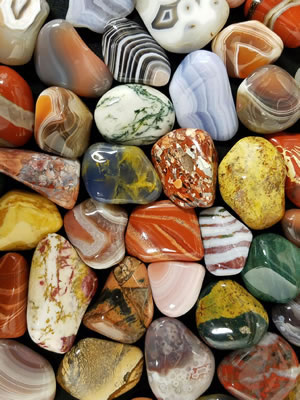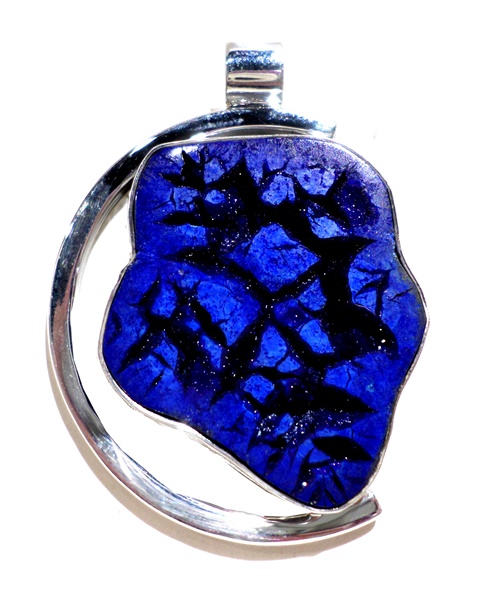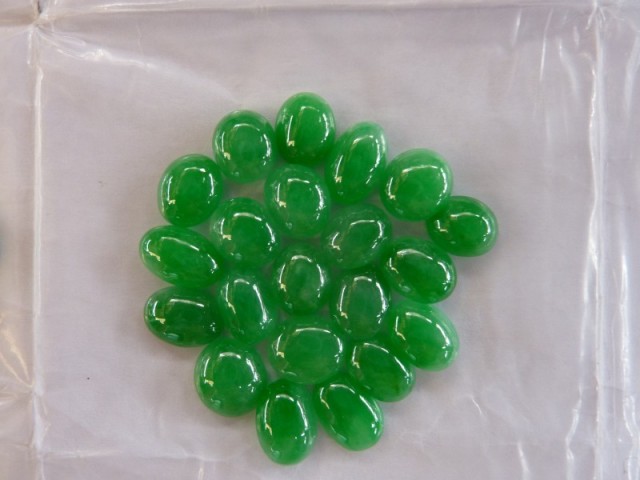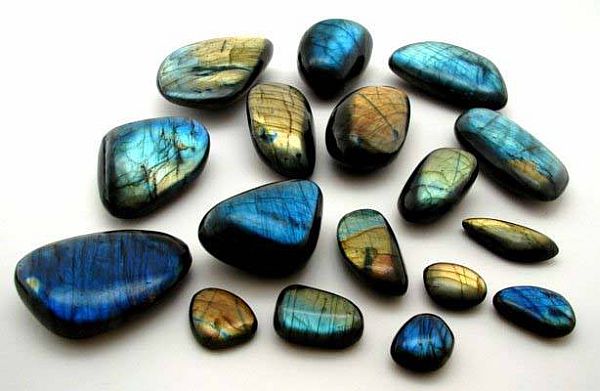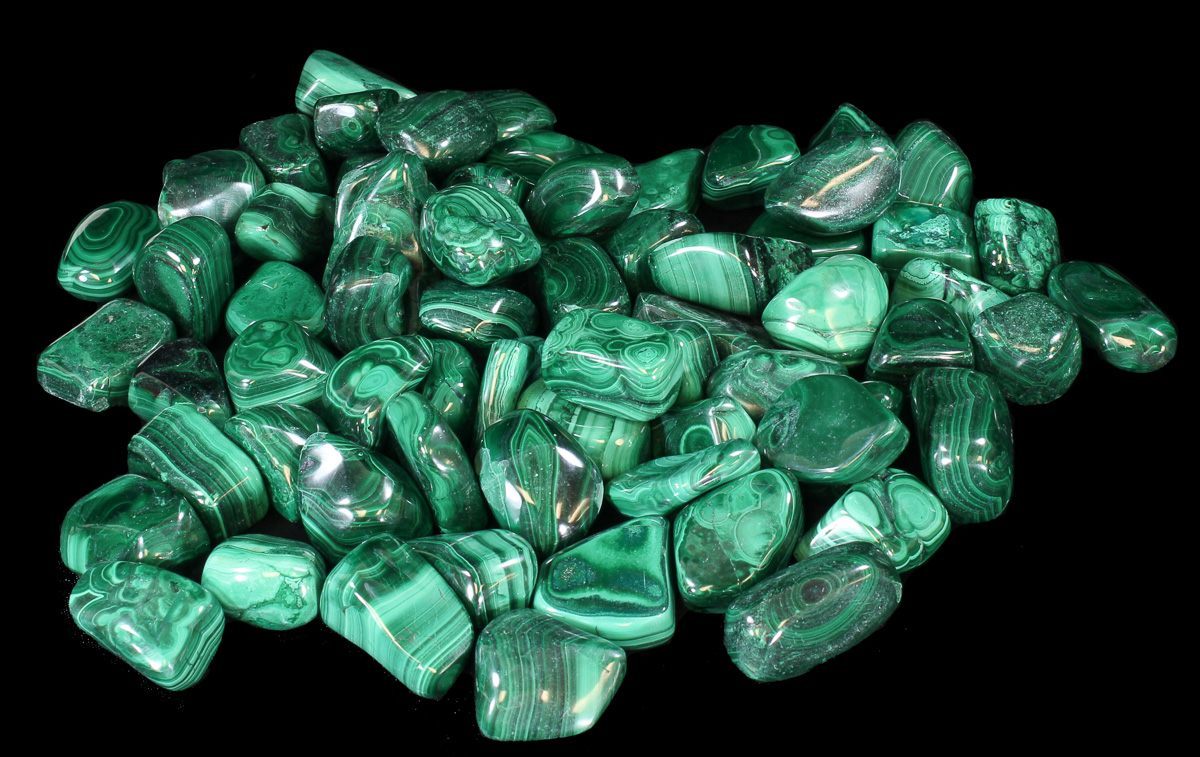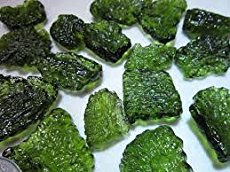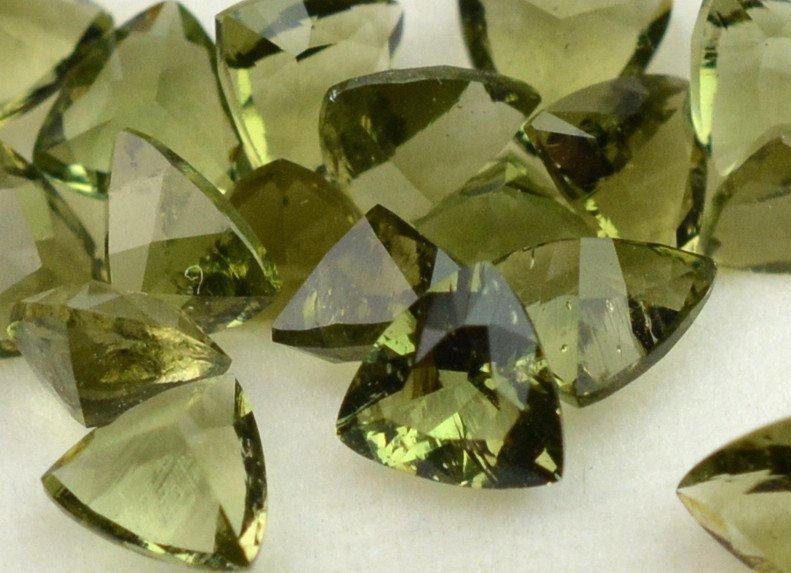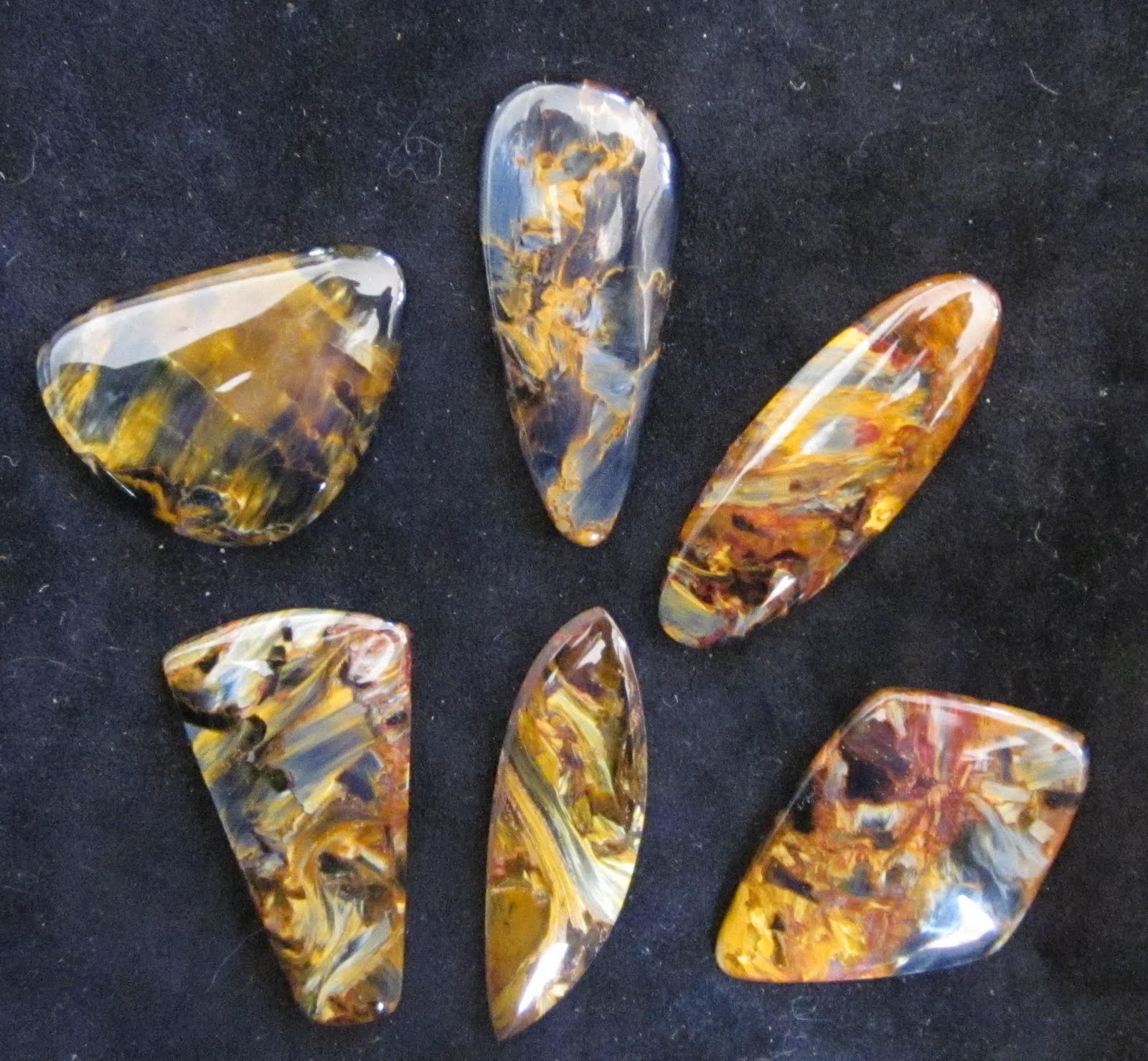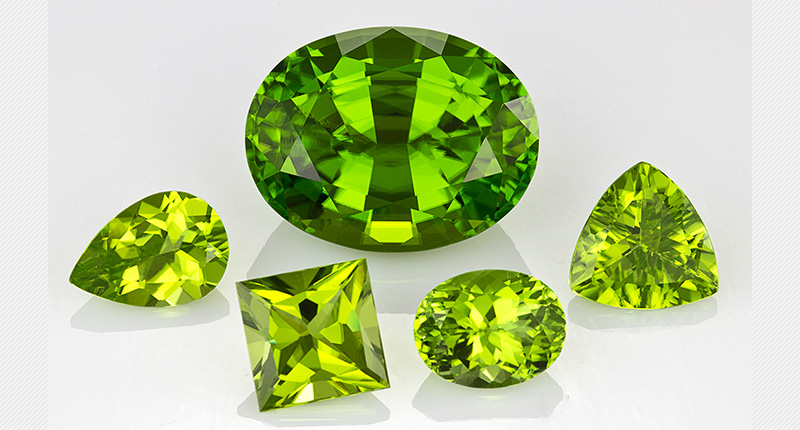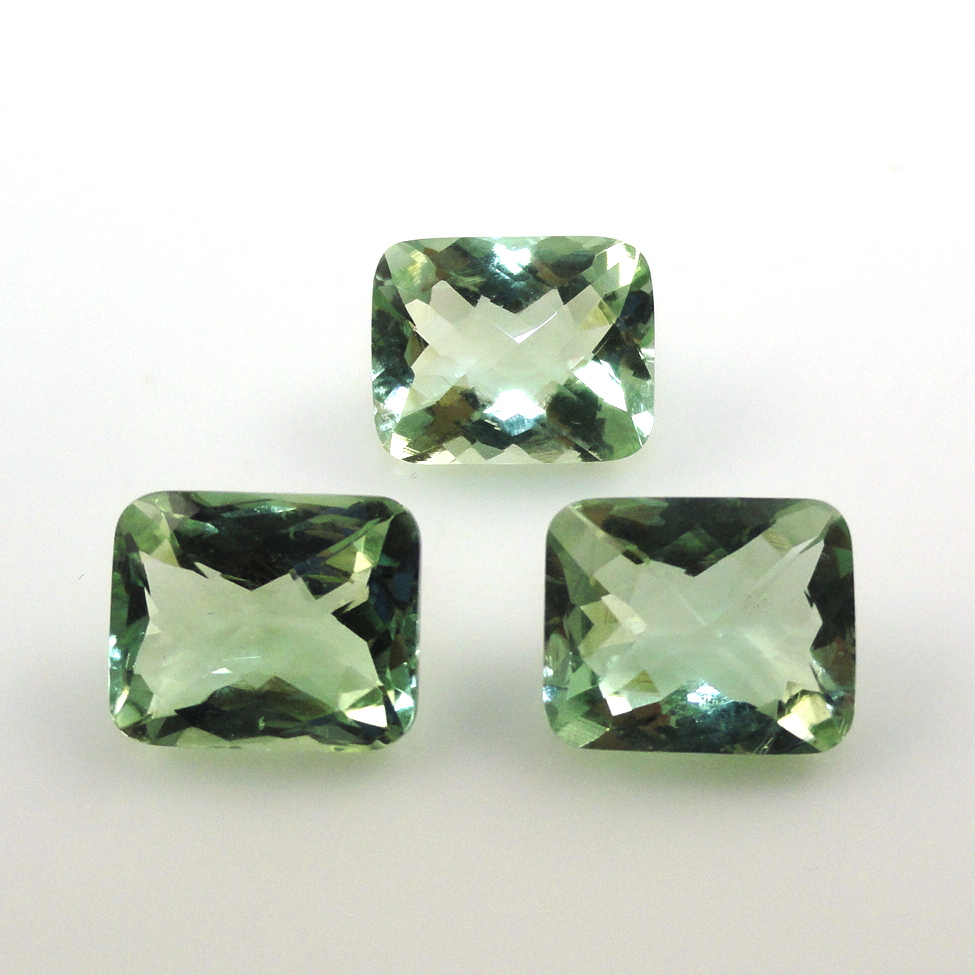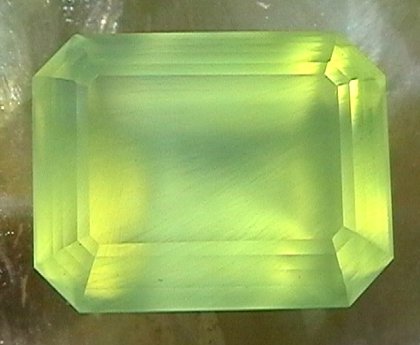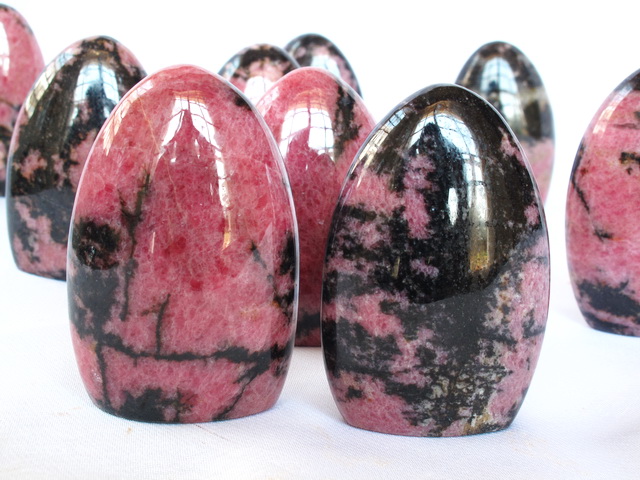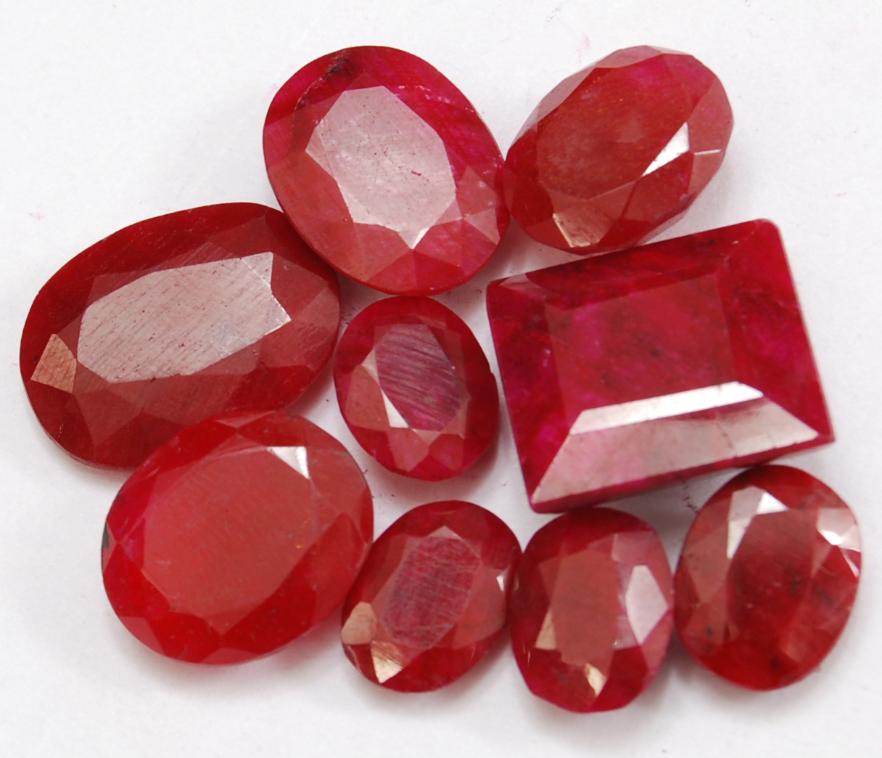There are over 3,000 different minerals, but only about 50 are commonly used as gemstones! So what makes a gemstone?
Generally speaking, a gemstone is a stone that is beautiful, rare, and durable (resistant to abrasion, fracturing and chemical reactions). Some minerals can be very beautiful, but they may be too soft and will scratch easily. Others are too common and are given a semi-precious status. Most gemstones have good hardness (above 5) and a high index of refraction (the higher the index of refraction the greater the sparkle). All gemstones have some characteristics falling short of perfection though; even the seemingly perfect Diamond. Most gems are silicates which can be very stable, hard minerals. A few gems are oxides and only one gem, diamond, is composed of a single element, carbon. There are also many gemstones that are not true minerals, but which are gemstone varieties of recognized minerals.
A few gemstones are mineraloids (not true minerals) such as opal, amber, and moldavite. Pearls don't even qualify as mineraloids, as they are not only the result of an organic process they are also composites, containing both the mineral aragonite and the protein conchiolin.
Agate Ancient Coins Amazonite Amber Amethyst Ametrine Ammonites Apatite Aqua Aura Aquamarine Aventurine Bumble Bee Jasper Chalcedony Charoite Chinese Writing Stones Chrysocolla Chrysoprase Cinnabar Citrine Coral Diamonds Druzy Emerald Fluorite Fordite Gaspeite Hematite Hemimorphite Iolite Jade Jasper K2 Afghanite Kyanite Laboradite Lapis Lazuli Larimar Malachite Moldavite Moonstone Mother of Pearl Ocean Jasper Onyx Opal Orthoceras Peanut Wood Pietersite Pearl Peridot Prasiolite Prehnite Psilomelane Quartz Rhodochrosite Ruby Ruby Zoiscite Sapphire Smoky Quartz Sodalite Sugilite Tiger's Eye Topaz Tourmaline Turquoise Variscite
Agate
Agate is a hard stone, usually within the range of 7-9 on the Mohs scale. Agates are found in almost all colors of the rainbow. Agate is a variety of chalcedony formed from layers of quartz which usually show varicolored bands. It usually occurs as rounded nodules or veins. Often tiny quartz crystals form within the stone and add to the beauty and uniqueness of individual stones. These crystals are called drusy. Agate is a relatively inexpensive stone except for some varieties with unusual banded or scenic markings. Agate is found all over the world . Back to Top
Apache Gold -
This lovely semi precious gemstone cabochon material is known as Apache Gold. It is bright and shiny gold Chalcopyrite in a black Schist found in "The Big Hole" in Jerome, Arizona. Located high on top of Cleopatra Hill (5,200 feet) between Prescott and Flagstaff is the once thriving mining town of Jerome, Arizona. The town was established in 1883. In 1918 fires spread out of control over 22 miles of underground mines, burning the inflammable massive pyrite. One of the mine fires continued to burn for twenty years. United Verde moved to open pit mining instead of underground. Blasting in the mines frequently shook the town, sometimes damaging or moving buildings; after one blast in the 1930s the city jail slid one block downhill intact. By 1953, after belching copper for more than 70 years (and about 800 million dollars worth!), the mine was closed down. Now it is mostly a quaint little tourist town. Due to the 30-degree incline of the mountainside, gravity is pulling the entire town down the slope!
Chalcopyrite has been referred to as Fool's Gold because it is such a bright gold color and the black in this material is dark black, creating quite a striking contrast. Apache Gold semi precious gemstone cabochons take a high polish. Metaphysical Properties: Chalcopyrite is believed to increase happiness and believe in oneself. It is also said to assist one in finding lost objects!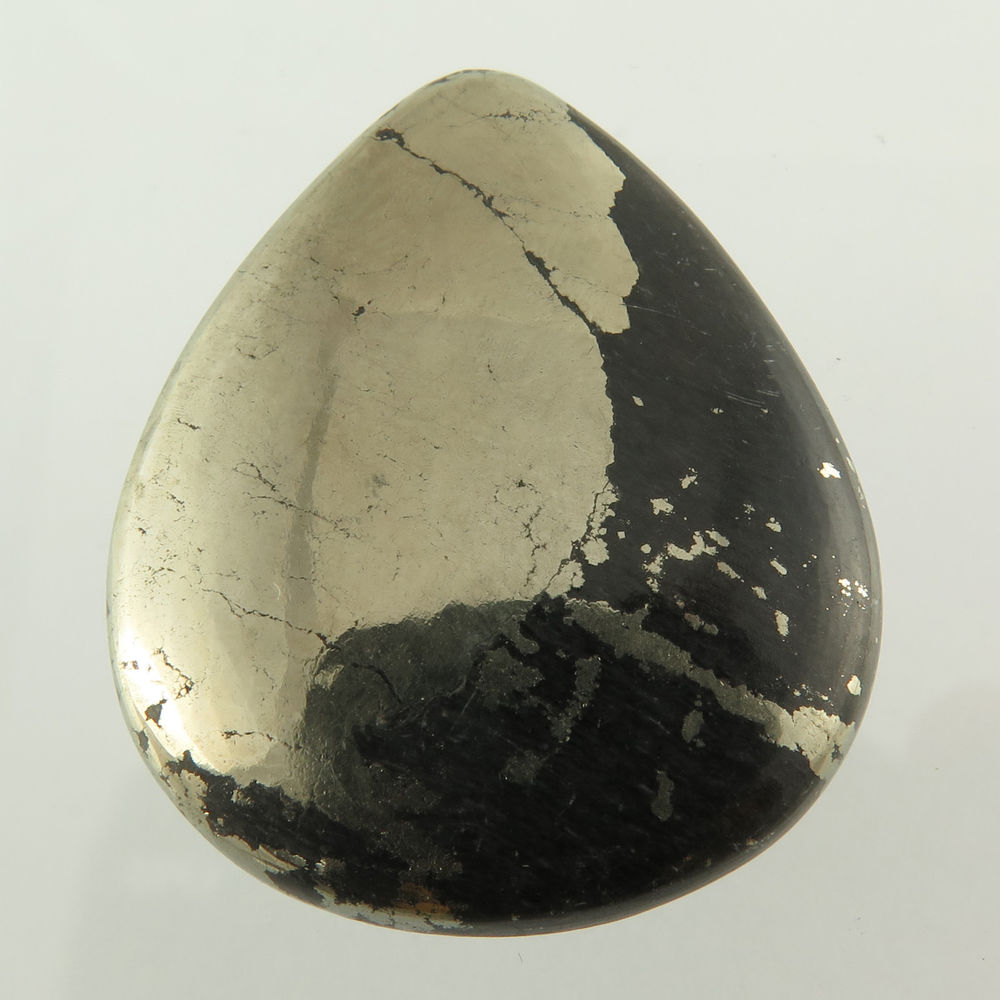
Amazonite
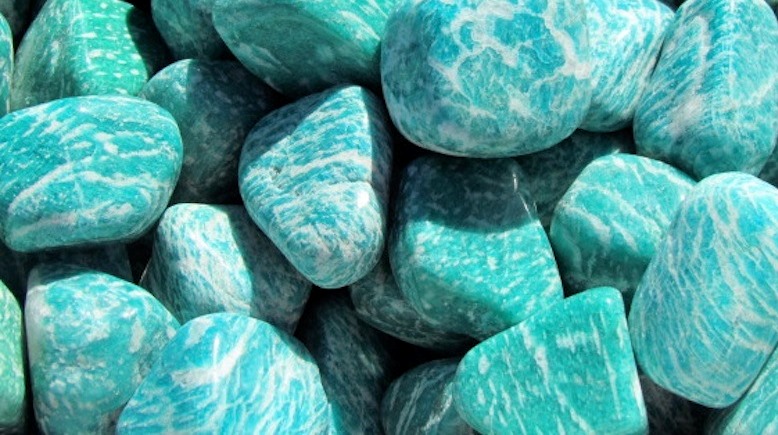
Amazonite is a variety of green microcline feldspar. It is named after the Amazon River in Brazil but surprisingly no deposits of it have been found there. A Brazilian legend tells that the Amazons, the legendary female warriors, gave green stones to the men who visited them. Amazonite, is usually cut with a rounded and convex polished surface. Amazonite does not undergo any kind of treatment. Its relative softness of 6-6.5 on the Mohs scale makes Amazonite vulnerable to scratches and requires some care. Amazonite, though not common, is still very affordable.
Amazonite is said to calm one's emotions and soothe nerves, and to enhance creativity and the ability to express oneself. Perhaps the strongest recommendation of its metaphysical powers is that Amazonite is said to make your married life happier. The deeper the color of the amazonite, the more intense the effect is said to be. Back to Top
Amber

Amber deposits have been found that range between 360 and one million years old and belong between the Carboniferous and Pleistocene geological periods. As sticky resin oozed from ancient pine trees over time the resin was encased in dirt and debris and through a process of heat and pressure it fossilized to become amber. It burns at low temperatures and can darken with age. Amber can range in color from dark brown to a light almost clear lemon yellow. Most amber that has been used in jewelry is from the region of the Baltic Sea or the Dominican Republic. Amber is very soft, between 2 1/2-3 on the Mohs scale. Copal, is also a tree resin but it hasn't fully fossilized to amber. It is usually only thousands of years old, instead of millions of years. Back to Top
Amethyst

Amethyst - It is derived from the Greek word "not to intoxicate", which led to the belief that drinking wine from an amethyst cup would prevent drunkenness. Amethyst was thought to protect soldiers, ensure victory, aid hunters, protect against disease, control evil thoughts, and quicken one’s intelligence. It is said to be a surface cure for headaches and toothaches, and is used to increase spirituality. Back to Top
Ametrine
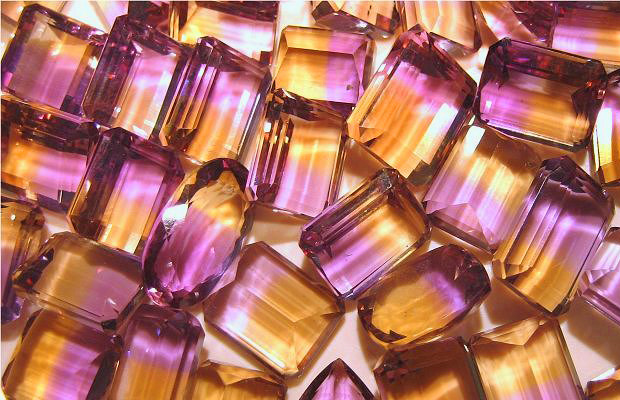
Ametrine– A scarce natural combination of amethyst and citrine. Native Indians of the Bolivian Ayoreo tribe gave the mine to a 17th century conquistador as dowry for marrying Princess Anahi. With the passing of the centuries, the Anahi mine was forgotten to the world. Some 300 years later is has been rediscovered. But getting this stone is no easy feat! Start with getting to the Pantanal/Chaco region, charter a boat for a six hour trip up the Paraguay River, and then take an 18 mile trek through dense jungle. Permission from the owner of the mine is required! The color purple represents spirituality, passion, mysticism and faith. Yellow signifies mental and spiritual enlightenment, vitality, and hope. Together this blended stone presents the wearer with a gem that is symbolic of spirituality, steadfast loyalty, and a zest for life. Back to Top
Ammonites
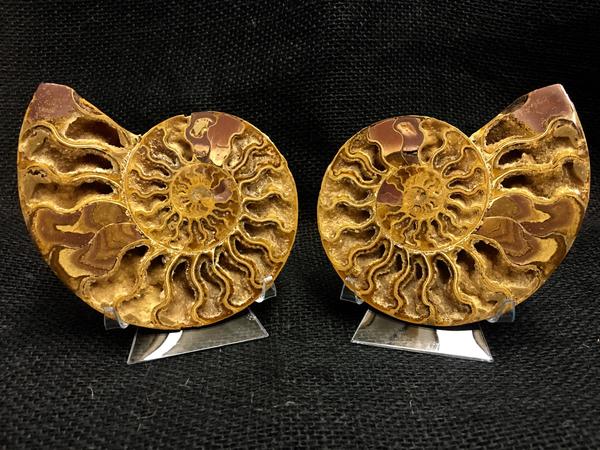
Ammonites are named after the Egyptian god Ammon, who is often depicted with rams' horns behind each ear. Ammonites were predatory, squid-like creatures that lived inside coil-shaped shells. Ammonites first appeared 240 million years ago. They were prolific breeders, lived in schools, and are among the most abundant fossils found today. They went extinct with the dinosaurs 65 million years ago. Ammonite is a spiritual indication of harmony, dignity, and splendor. Ammonites give you a sense of beauty, seductive charm, and charisma. It awakens interest in mysteries and releases mental obsessions. Ammonites are the ancient equivalent to the modern-day chambered Nautilus. These sea faring squids built a chambered shell in which they would pump air into the empty chambers and float at different levels of the ocean in search of food. This unique ability to float at different depths of the ocean is what inspired Jules Vern (the famous science fiction writer) to call the first submarine the Nautilus. Back to Top
Apatite
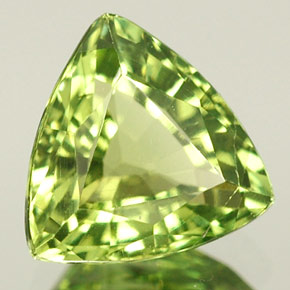
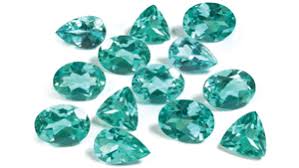
Apatite originates from the Greek word for "cheat". That unfair title was allegedly earned from apatite's possible confusion with other stones. It is a stone seldom found in jewelry stores and virtually unknown to the general public, is beloved by collectors for its many different colors and forms. The range of colors includes colorless, pink, yellow, green, blue and violet. Back to Top
Aqua Aura
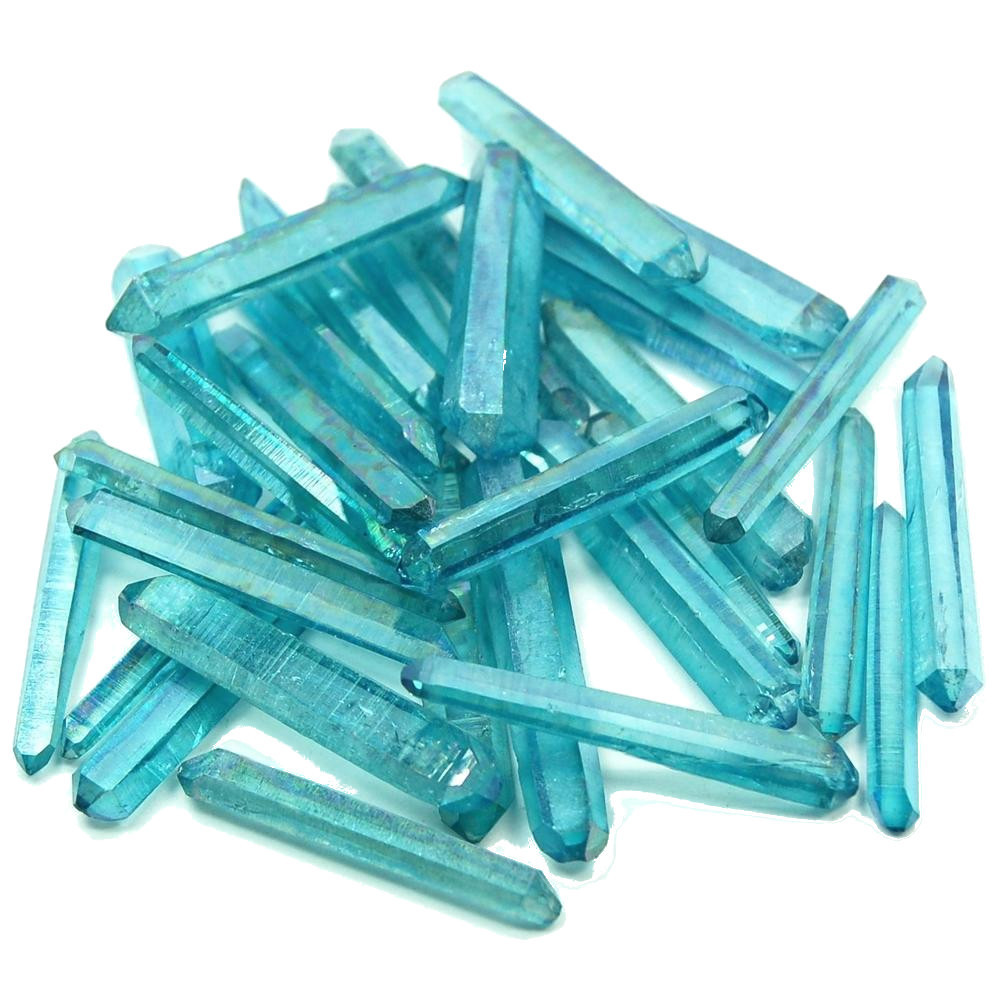
With a hardness of 7, Aqua aura is quartz that is gold infused. It is created by heating quartz crystals to over 1500F in a vacuum. Once the right heat and vacuum is attained, chemically purified gold vapors are let into the chamber with the crystals. This bonds the gold to the lattice of the crystal, forming a permanent bond to the surface of the quartz, giving it an electric blue color. Though not created through a natural process, the synergy of the quartz and gold combine to bring about a new crystal of intense energy and power. Aqua Aura is used by crystal healers and others to calm the emotions. It is a powerful stress reliever. It is also a strong energy for reducing or eliminating anger. It is said to help process emotional disturbances, grief, and traumas to a point where they are no longer stressful. Aqua Aura is called both a success stone and an abundance stone. It is said to attract success to all who use or carry it.
Aquamarine
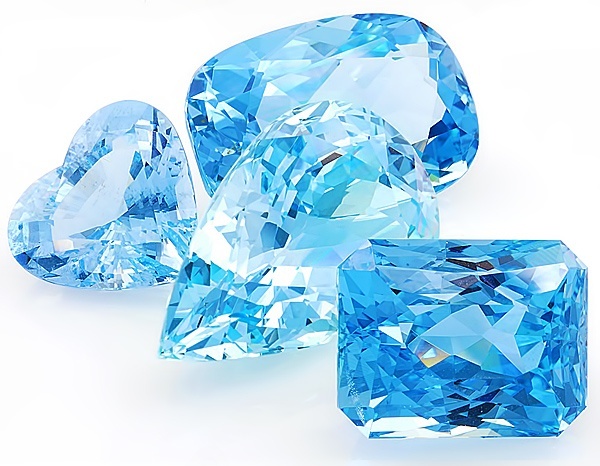
The gemstone Aquamarine is the modern March birthstone. Aquamarine is a member of the beryl family and ranges in color from an almost colorless pale blue to blue-green or teal. The most prized color is a deep-blue aqua color. It is 7.5-8 on the Mohs scale of hardness and gets its name from Latin words meaning water and sea. The most valuable aquamarines come from Brazil. Since early times, aquamarine has been believed to endow the wearer with foresight, courage, and happiness. It is said to increase intelligence and make one youthful. As a healing stone, it is said to be effective as a treatment for anxiety and in the Middle Ages it was thought that aquamarine would reduce the effect of poisons. A legend says that sailors wore aquamarine gemstones to keep them safe and prevent seasickness. It also signifies the making of new friends. Back to Top
Aventurine
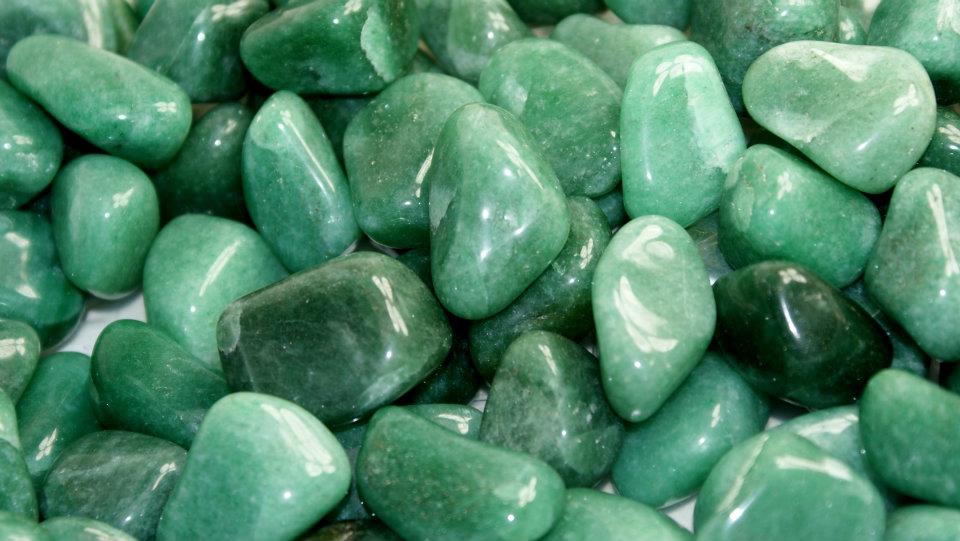
Aventurine is a translucent to opaque variety of microcrystalline quartz. It contains small inclusions of shiny minerals which give the stone a sparkling effect. Inclusions of mica will give a silverish sheen, while inclusions of hematite give a reddish or grayish sparkle. Aventurine ranges in color from green, peach, brown, blue and a creamy green. Besides its uses in jewelry, aventurine is also used for ornamental purposes like vases, bowls, and figurines. It is a 6.5 on the Mohs scale of hardness. This mineral is often mistaken for amazonite or jade. It is interesting that the name for the stone is derived from an accident. Sometime during the 18th century, Venetian glass workers were preparing molten glass when copper filings accidentally fell into the batch producing a glass with sparkles. The name aventurine comes from the Italian "a ventura," which means"by chance". Aventurine has been used as a lucky talisman and is a popular stone for gamblers. Legends say that it is an all-purpose healer, used to reduce stress, develop confidence, imagination and improve prosperity. A legend from ancient Tibet says that aventurine was used to improve nearsightedness and to increase the wearer's creativity. Many believe that aventurine has the capacity to calm a troubled spirit and bring about inner peace. Back to Top
Azurite
Azurite is an intense deep blue color. For thousands of years this stone has been used in jewelry and ornamental objects. During the Middle Ages and Renaissance it was ground into pigment for use in paint and eye shadow. Azurite was sacred to the Egyptians who believed it was an aid to spiritual communication. Many believe that this stone helps to reduce anger and to increase psychic awareness. It is also thought to reduce abnormal cell growth, promote wisdom, and is used as an aid to relieve the pain of rheumatism.
Bumble Bee Jasper
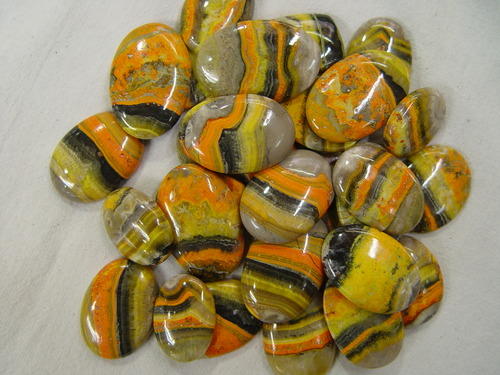
Bumblebee Japer, is found on the island of Bali, near the town of Garut, Indonesia. It is collected by locals near hot vents of an active volcano called Mount Papandayan. The peak is around 8,700 feet high, which is one of the tallest volcanoes in Indonesia. Bumblebee Jasper cabochons are not really a chalcedony, jasper or agate, but are actually a mixture of volcano lava and sediment. The colorful Bumblebee contain gypsum, sulfur, hematite and a small amount of orpiment. Metaphysical Properties: Bumblebee Jasper cabochons are said to help your concentration and inspiration by helping you focus better.
Carnelian
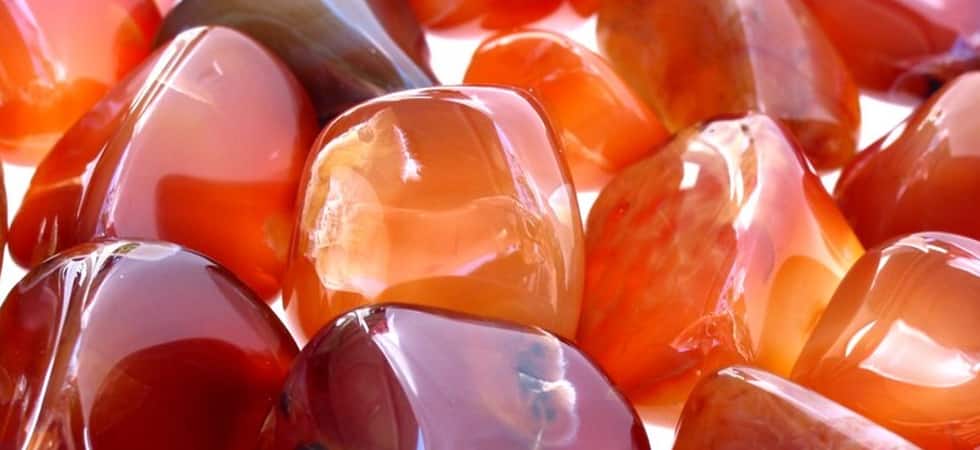
Carnelian – In the eighth century, the Muslim leader Ja’afar ibn Muhammad proclaimed that wearing Carnelian would guarantee the granting of all desires. This belief made the stone a popular talisman among the Muslims. In the 1700’s, carnelian was known to bring luck, protection, and comfort. In the 1800’s, carnelian was said to help those who needed courage to speak. This gemstone is used for clear thinking and to balance creativity and mental processing. Back to Top
Chalcedony
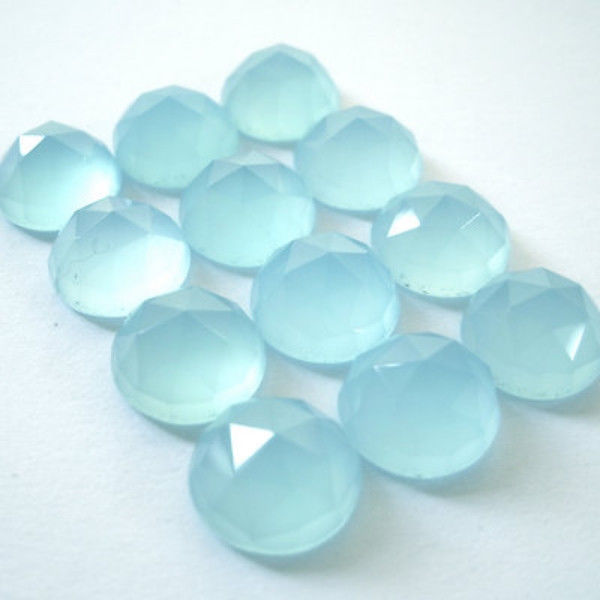
Chalcedony is derived from the name of the ancient Greek seaport Chalkedon in Asia Minor. Inthe 3rd or 4thcentury A.D., Greek seafarers wore chalcedony to avoid drowning. Chalcedony, which is found worldwide, is the name for a group of stones made of a microcrystalline variety of quartz, which means the quartz crystals are too small to be seen without high magnification. In jewelry usage, the name Chalcedony is usually applied only to the light blue translucent and waxy form. Other stones in this group are know as agate, jasper, bloodstone, tiger's eye, chrysocolla, chrysoprase, onyx, sardonyx, and carnelian. Chalcedony is found in almost every color. Native American Indians believed chalcedony was a sacred stone and used in the spiritual ceremonies of the tribe.It is thought to increase vitality, stamina, and endurance and to promote emotional balance and charity while relieving melancholy, fever, gallstones, and eye problems. It was once believed that someone seeing nocturnal phantoms took in disease though their eyes, but the "alkaline" content of chalcedony could remove it. Back to Top
Charoite
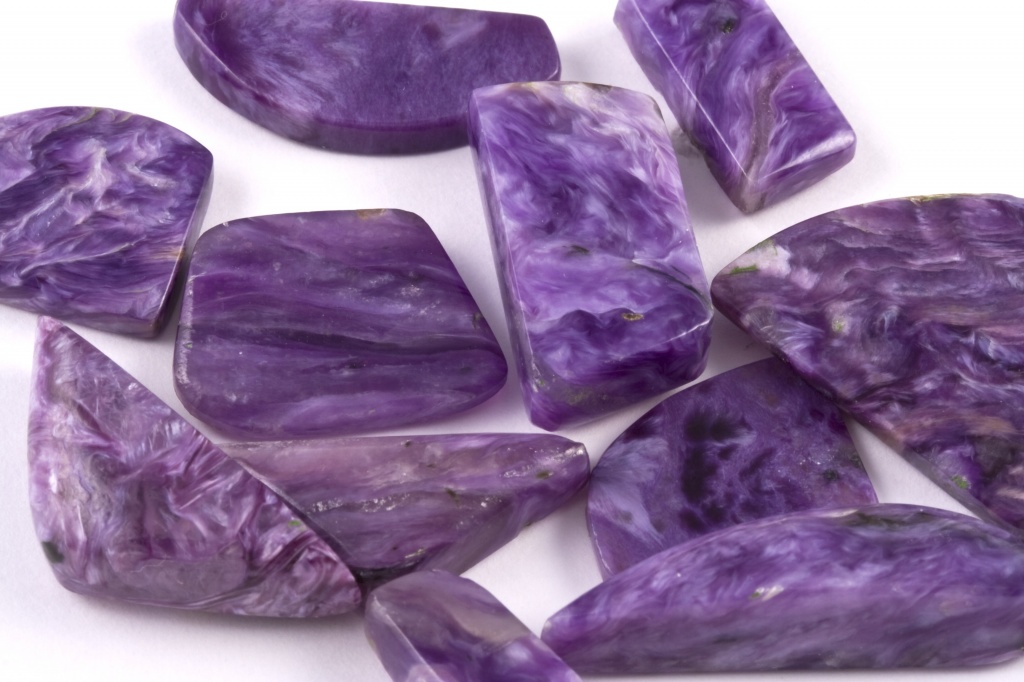
Charoite name is derived from the Charo River which is near where it was found in Russia in 1978 in the Murun mountains in Yakutia. This the only known location for this rare mineral. The colors range from bright lavender, violet and lilac to dark purple with swirling patterns of black Augite, transparent crystals of microcline feldspar, and/or orange Tinaksite. Charoite is so unusual looking with its chatoyancy and strange looking spirally strands of fibrous material that it is often mistaken for a synthetic. It is used extensively in jewelry and as an ornamental stone carved into boxes, bookends and vases. It ranges from 5 - 6 on the Mohs scale. Charoite is said to enhance self-esteem, accelerate spiritual growth, and improve the ability to love. Back to Top
Chinese Writing Stone
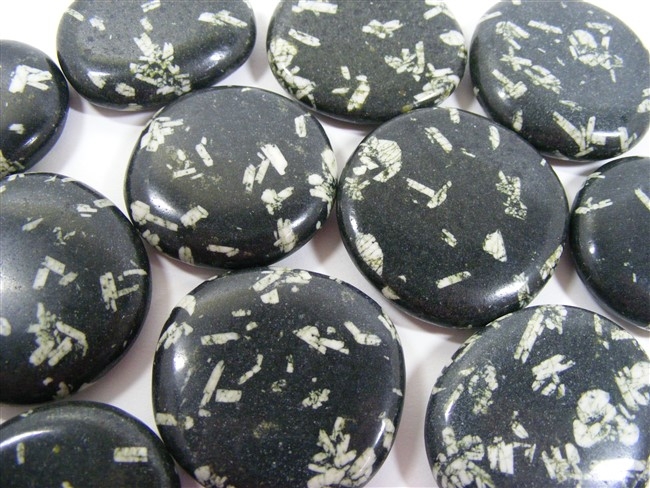
Chinese Writing Stone was probably named because of the crystalline structure resembling the Chinese characters of the written language. It is a limestone matrix with andalusite crystals. It is also called Porphory. This stone comes from the Yangtze River Valley of the Hunan Province of China. Colors range from a very dark gray or almost black to creamy white, both of which have a slight greenish cast. A dramatic looking stone, it is a 5-6 on the Mohs scale.It is an excellent stone for dreaming, assisting one into a dream state and it is a stone of re-affirmation, re-alignment and re-commitment. It helps one to adjust to change, accept responsibility and stimulate originality Back to Top
Chrysocolla
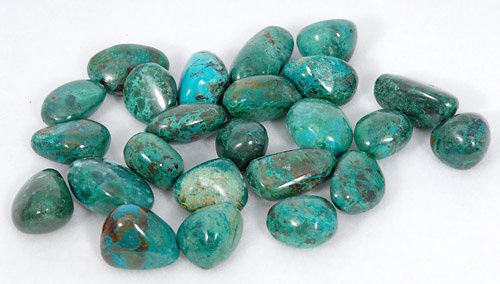
The gemstone Chrysocolla is often confused with turquoise. It is a copper bearing mineral found wherever copper deposits occur especially in areas of the southwestern USA, Chili, Zaire, Australia, France and England. Eliat Stone is a variegated blue and green mixture of chrysocolla and other copper minerals found in the Gulf of Aqaba, near the northwestern end of the Red Sea". Pure chrysocolla is too soft for jewelry purposes but it is often found in quartz deposits which makes it hard enough to polish for cabochons. It is often found mixed with malachite, turquoise and azurite. Pure chrysocolla is between 2.0 and 4.0 on the Mohs scale of hardness. Said to aid creativity, female energy, communication,relieves ulcers and arthritis. Chrysocolla is associated with tranquility and peace, intuition, patience, and unconditional love. It is thought to offer gentle and soothing qualities. Back to Top
Chrysoprase
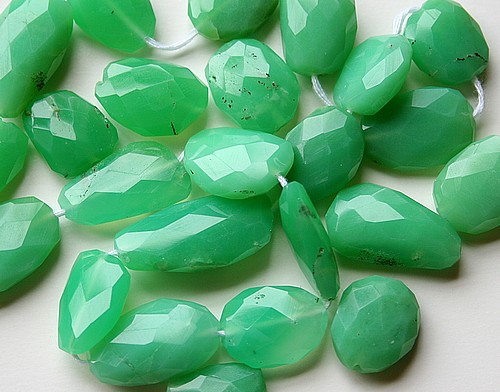
Chrysoprase– was once used for spiritual protection and was said to be a victory stone. In the 1800’s it was believed to help thieves escape execution by becoming invisible if a Chrysoprase was held in their mouth. Chrysoprase is a natural green color gemstone from Queensland, Australia, and is often referred as Australian Jade. Back to Top
Cinnabar
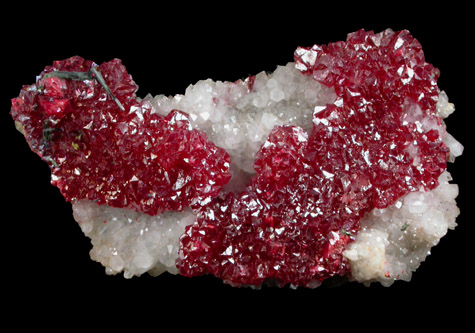
Cinnabar is a red crystalline form of mercuric sulphide. In its natural state, it is a red crystalline solid. Sometimes, its red color is so bright that it is not found in any mineral, plant and animal on earth. It occurs in brilliant red or in red or brown amorphous masses. The Chinese and the Arabian alchemists used to extract mercury from it. Today, it is the only source of mercury and is found in rare localities. Since of its red color, it was also used as a dye. The word 'Cinnabar' has been taken from the Persian for 'dragon's blood.' Cinnabar is believed to be protecting people from evil and to bring good luck and fortune. Psychologically, it represents the hardened habits and terrestrial marriages of the soul and spirit. Cinnabar is also a stone of repute in giving wearer long life. The hardness of cinnabar is 2 to 2.5 and is usually used for making beautiful jewelry. It is found in the regions of Spain, Serbia, China, and California and Arkansas in the US. Back to Top
Citrine
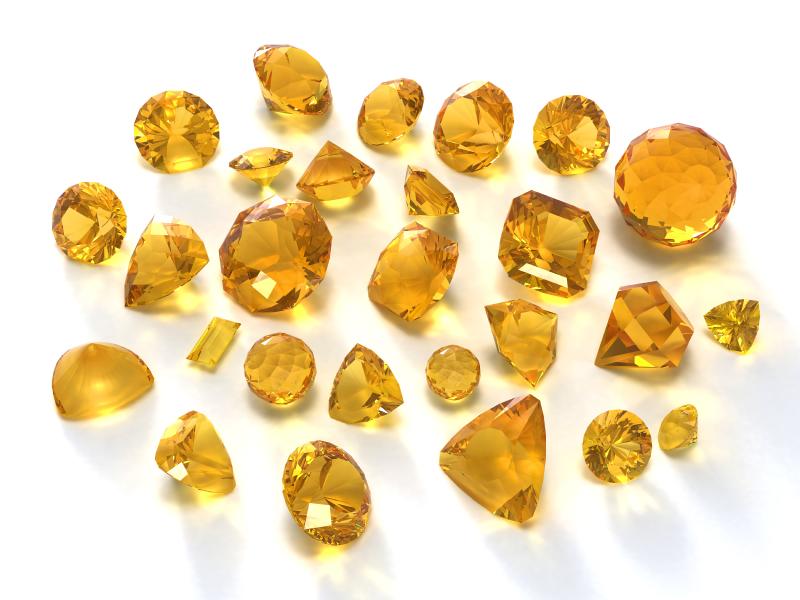
Citrine – The birthstone for November and the top selling gem in the yellow to orange color. Citrine's color is thought to radiate positive energy. It is known as the 'success stone', since it is believed to promote prosperity and abundance, especially in situations involving business. Citrine has actually earned the nickname of 'the merchant's stone', owing to the fact that many businesses will keep citrine in their cash registers for good fortune. According to legend, citrine is able dissipate negative energy. It is also thought to generate stability in life and be good for general protection. The name is derived from the French word citron, meaning "lemon". Back to Top
Coral
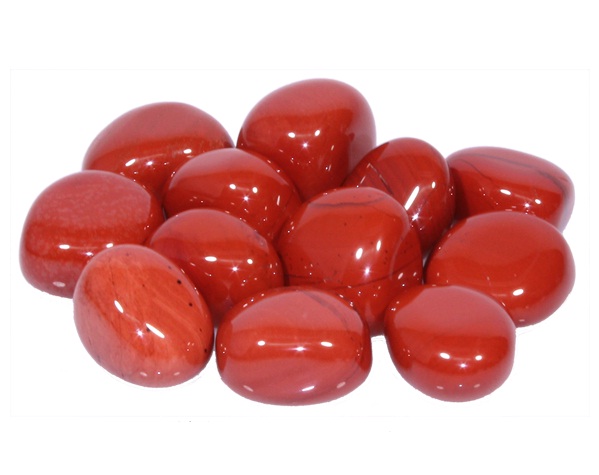
Coral – Is thought to protect against magic spells, to cure madness and to give wisdom. In many cultures, coral is given to children as a gift for their protection. Back to Top
Copper is a soft, malleable and ductile metal with very high thermal and electrical conductivity and a resistance to corrosion. Copper is found as a pure metal in nature, and this was the first source of the metal to be used by humans, ca. 8000 BC. It was the first metal to be smelted from its ore, ca. 5000 BC, the first metal to be cast into a shape in a mold, ca. 4000 BC and the first metal to be purposefully alloyed with another metal, tin, to create bronze, ca. 3,500 BC. Copper is one of four metallic elements with a natural color other than gray or silver. Copper is said to promote harmony and love for all beings.
Diamonds

Diamonds are very rare gemstones. Many of them are clear, but they may have colors. There are natural and synthetic diamonds. Diamond is the hardest natural material known, where hardness is defined as resistance to scratching and is graded between 1 (softest) and 10 (hardest) using the Mohs scale of mineral hardness. Diamond has a hardness of 10 (hardest) on this scale. Diamonds are actually made of pure carbon. In fact, the only thing hard enough to cut a diamond is another diamond. Diamonds are made deep in the earth, where there is an intense amount of pressure and heat that makes the diamond form. The name diamond is derived from the ancient Greek, "unalterable" and "unbreakable, however, diamonds are thought to have been first recognized and mined in India for at least 3,000 years. The popularity of diamonds has risen since the 19th century because of increased supply, improved cutting and polishing techniques, growth in the world economy, and innovative and successful advertising campaigns.
The hardness of diamonds contributes to its suitability as a gemstone. Because it can only be scratched by other diamonds, it maintains its polish extremely well. Unlike many other gems, it is well-suited to daily wear because of its resistance to scratching—perhaps contributing to its popularity as the preferred gem in engagement or wedding rings, which are often worn every day. The mined rough diamonds are converted into gems through a multi-step process called "cutting". Diamonds are extremely hard, but also brittle and can be split up by a single blow. Therefore, the diamond cutting is traditionally considered as a delicate procedure requiring skills, scientific knowledge, tools and experience. Its final goal is to produce a facetted jewel where the specific angles between the facets would optimize the diamond luster, which is the dispersion of white light, whereas the number and area of facets would determine the weight of the final product. The weight reduction upon cutting is significant and can be of the order of 50%. Several possible shapes are considered, but the final decision is often determined not only by scientific, but also practical considerations. For example the diamond might be intended for display or for wear, in a ring or a necklace, singled or surrounded by other gems of certain color and shape.
Because of its unique brilliance and superior hardness, diamond has come to symbolize eternal love. The tradition began in the 15th century, when Archduke Maximilian of Austria sealed his engagement to Mary of Burgundy with a diamond ring. Diamonds symbolize brilliance, constancy, excellence, innocence, invulnerable faith, joy, life, love and purity. Back to Top
Druzy
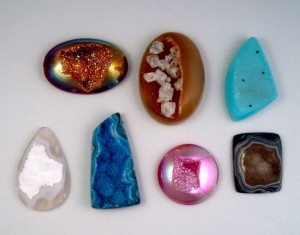
Druzy Quartz (also spelled as Drusy) - Druzy is tiny quartz crystals that form within or on the surface of other stones. When ground water carrying dissolved silica is forced into a porous area of the rock, rapid cooling often occurs, causing the formation of tiny crystals on the surfaces or in cavities of the rock. The clear crystals often form on top of previously deposited minerals. This is called a druzy. Titanium druzy is agate druzy that has been coated with titanium in a vacuum chamber. This produces a permanent metal coating in spectacular colors. Usually Druzy Quartz takes the host stone's color. Druzy Quarts is said to aid in balancing and increasing energy. Since ages it has been used to diagnose disease and is believed to enhance natural extrasensory perception abilities. Back to Top
Dioptase -Dioptase is very fragile and specimens must be handled with great care. Dioptase was used to highlight the edges of the eyes on three Pre-Pottery Neolithic lime plaster statues that date back to about 7200 BC. Dioptase is an uncommon mineral found mostly in desert regions. Dioptase is popular with mineral collectors and it is occasionally cut into small emerald-like gems. Although Diopside and Dioptase seem like they might be closely related, they are really far apart. One is a hydrated secondary copper mineral while the other is a magnesium iron mineral found in metamorphic rocks.
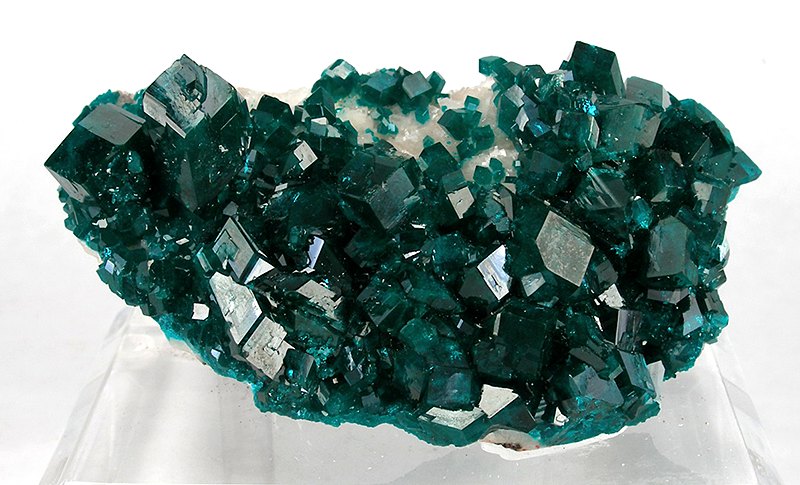
Emerald

Emerald is the only stone, besides Topaz, that is listed as in all of the ancient birthstone tables. Emerald is the name given the green variety of beryl and ranges between 7.5 and 8 on the Mohs scale. The name Emerald is derived from the French "esmeraude” and the Greek root "smaragdos” which means 'green gemstone'. Top quality emeralds are a deep grass green with a slightly bluish cast, but many lesser quality stones are lighter shades of green and can have a more yellowish tone. Emeralds are found in many countries, but Columbia and Brazil are the major producers and Columbia is recognized as the source for the finest stones. Because emeralds usually contain many cracks, fissures, and inclusions, the majority of these stones are "oiled". This means that they are immersed in oil which reduces the visibility of the inclusions, and also improves the clarity. Oiling is almost universal and because it is so common today, it is not considered necessary to disclose this fact Emeralds are brittle stones and care should be taken when wearing or cleaning them. They should never be immersed in an ultrasonic or subjected to steam cleaning. Emeralds were used as amulets to ward off epilepsy in children and thought to cure diseases of the eye. Folklore suggests that these stones will improve memory, intelligence, and enhance clairvoyance thus helping to predict future events. They are also worn to enhance love and contentment. Cleopatra prized emeralds above all other gems. Back to Top
Fluorite
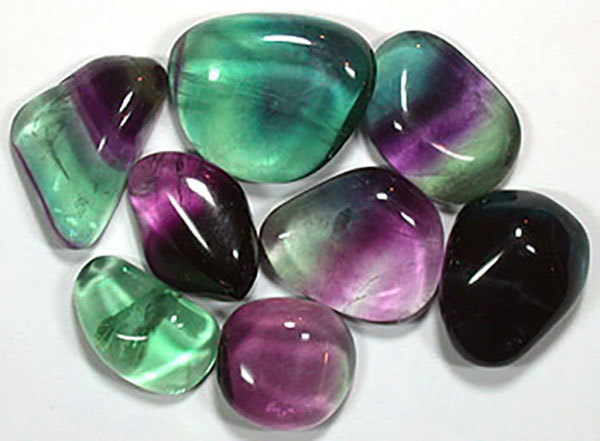
Fluorite, is a soft stone with a hardness rating of 4 on Mohs scale. Ancient Romans believed that drinking alcoholic beverages from vessels carved of fluorite prevented drunkenness. Most specimens of fluorite have a single color, but a significant percentage of fluorites have multiple colors and the colors are arranged in bands or zones. Fluorite is frequently fluorescent under ultraviolet light (UV) and, like its normal light colors, its fluorescent colors are extremely variable. Typically it fluoresces blue but other fluorescent colors include yellow, green, red, white and purple. The origin of the word fluorite comes from the Latin verb to flow and reflects today's use of fluorite as a flux in steel and aluminum processing. Fluorite is also used in the manufacture of high-octane fuels and in the production of hydrofluoric acid.
It is said to intensify emotions and moods – making them obvious. It also is said to aid freedom of choice, bring ideas, and a quick intellectual grasp. It is also said to be good for the skin, nerves, and bones. It was originally referred to as fluorspar by miners and is still called that today. Fluorite is also used as a source of fluorine for fluorinated water. Many people believe it has a calming effect on the body. During the eighteenth century it was ground into powder and mixed with water to treat kidney disease. Back to Top
Fordite
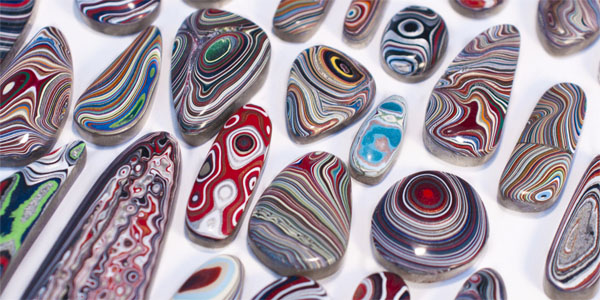
Fordite, is also known as Motor Agate. The original layered automotive paint slag was made by the now extinct practice of hand spray-painting cars. The over sprayed paint in the painting bays gradually built up on the tracks and skids that the car frames were painted on. Over time, many colorful layers built up there. These layers were hardened repeatedly in the ovens that the car bodies went into to cure the paint. Some of these deeper layers were even baked 100 times. Eventually, the paint build-up would become obstructing, or too thick and heavy, and had to be removed. The old factory methods that created this incredible material are long gone.
Garnet
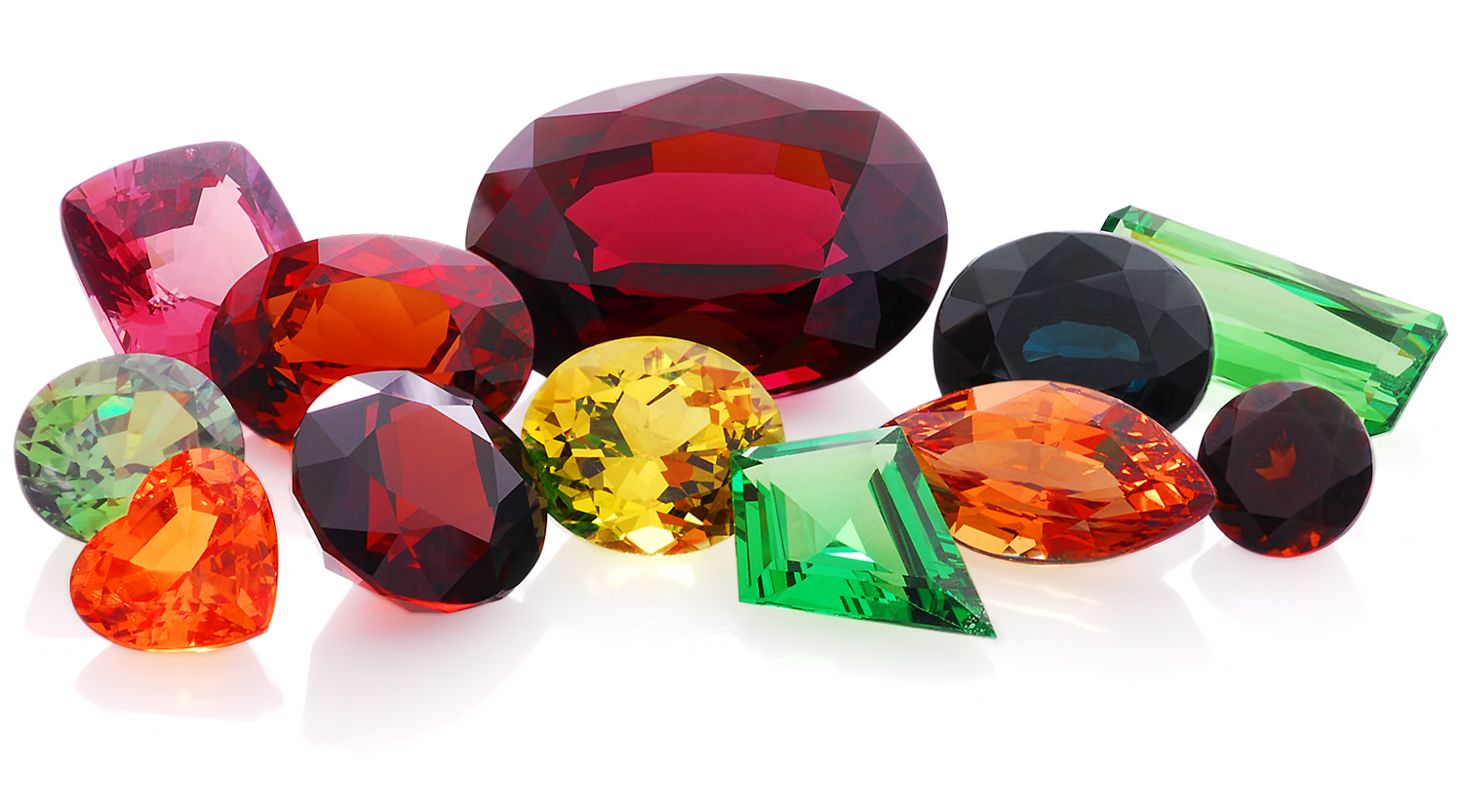
Garnet occurs in every color except blue and most varieties are named for their color. As far back as 3100 BC Egyptians along the Nile worked garnet into beads and inlays. Noah is said to have recognized garnet’s inner fire and used it as a lamp on the bow of the Ark. It is January’s birthstone and is mainly found in Brazil, India, Madagascar, Pakistan and the US. Rhodolite is a purplish red, Hessonite is the name for an orange, cinnamon, or pinkish variety. Tsavorite is the name given to dark green grossularite. Uvarovite and Demantoid are also green varieties. Pyrope garnets are purplish red, orangy red, crimson, or dark red. Spessartite garnets range from yellow and orange through red to reddish brown to dark black/brown. Garnets range from a 7.0 to 7.5 on the Mohs scale of hardness.
Garnet's powers include healing, strength, and protection and it is often worn to relieve inflammations of the skin. It is also believed to regulate the heart and blood flow and aid in curing depression. In earlier times, garnets were exchanged as gifts between friends to demonstrate their affection for each other and to insure that they meet again. North American Indians used red garnets at bullets, believing they would seek blood and inflict a deadlier wound. Christians believed garnets symbolized Christ’s sacrifice; Islamics believed it illuminated the fourth heaven. Garnets were thought to stop bleeding, cure inflammatory diseases, and smooth discord. Back to Top
Gaspeite
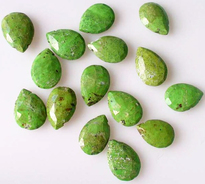
Gaspeite is a relatively rare mineral, found only in a few localities. Its light green, almost apple green color is quite unique and some varieties are almost a neon green. It may contain brownish patches which may give it a distinctive character. Gaspeite is found around nickel sulfide deposits and is named for the locality of Gaspe Peninsula, Quebec, Canada where it was originally found. Sources are Canada and Western Australia. Hardness is 4.5 - 5 on the Mohs scale. Back to Top
Hematite
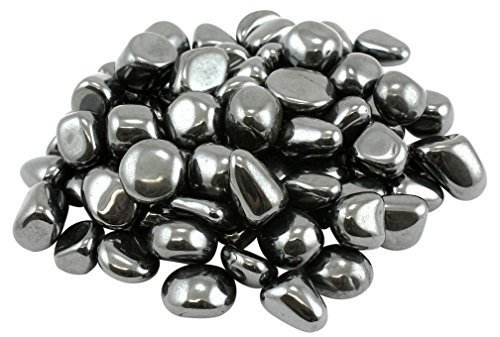
Hematite is a very common mineral consisting of iron oxide. Its color ranges from steel gray to almost black, brown to reddish brown, or red. Hematite is harder than pure iron, but it is much more brittle. The name hematite is derived from the Greek word haimatites for blood. It is mined in Australia, Brazil, England, Mexico, the United States and Canada. It is the state mineral of Alabama, USA where approximately 375 million tons were mined between l840 and 1975. Hematite (iron ore) is a very common mineral on Earth and it also occurs everywhere on the planet Mars - where it is responsible for the planet's distinctive red color. It was first identified on Mars by the Thermal Emission Spectrometer (TES), aboard Mars Global Surveyor. An important pigment known as "red ochre" it was used in cave paintings and paint pigment. Back to Top
Hemimorphite
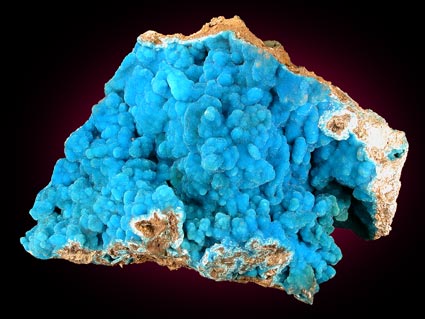
Hemimorphite forms in oxidized zinc deposits and always occurs in clusters of radiating, acicular crystals. 'Hemi' means half and 'morph' means shape. Hemimorphite is in the form of bladed crystal. The crystals are generally elongated and flat. When heated, the stone readily becomes frosted. When hot, the coating is yellow but after cooling it turns white. It even fluoresces a bright orange in long-wave ultraviolet and white in short-wave ultraviolet. It is a wide believe of Hemimorphite being a help for one to attain a positive self-image including self-esteem and self-respect. It also assists in the personal growth of a person on all levels. The stone brings joy and creativity. For healing, it is an excellent stone. It relieves pain, cures ulcers, blood diseases and cellular disease or disorder. Sometimes it is also used as protection stone from malice and poisoning. Back to Top
Iolite
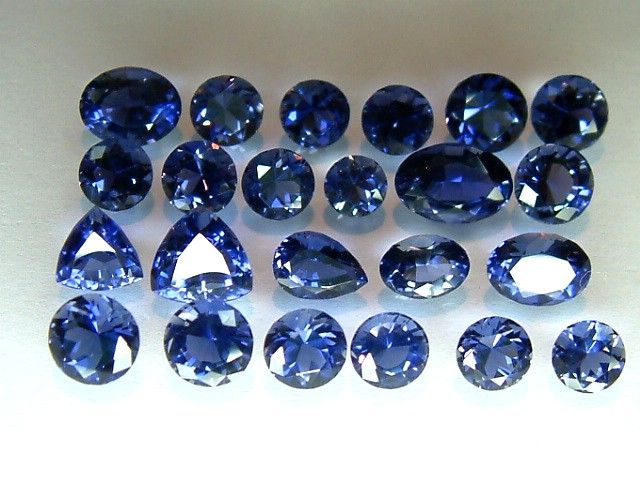
Iolite– from the Greek word meaning violet. Iolite shows different colors from different viewing angles and can appear gray, violet, or yellow. Iolite is known as the gemstone of clear vision. Viking navigators found their way on cloudy days by viewing the sky through a thin piece of Iolite which acted like a polarizing filter. Back to Top
Jade
Jade is the term applied to forms of jadeite and nephrite. These minerals are similar in appearance and a distinction between the two often was not made. But, because of its more intense color and translucency, jadeite now brings higher prices and is thought to be the true jade.The most valuable form of jade is known as Imperial jade and comes from Myanmar, it is an emerald green color. Jades also appear in mottled green and white, and the rarer colors of yellow, pink, purple, and black. The range of greens are light to dark, creamy, grayish, and also white. Jade is also found in Mexico, and Central and South America. Because of its smooth even texture, jade has long been a preferred material for carving and is usually cut into cabochons for jewelry. The color of the stone is the most important factor but translucency and texture are important criteria determining price. Jade is a 6 1/2-7 on the Mohs scale of hardness. Back to Top
Jasper
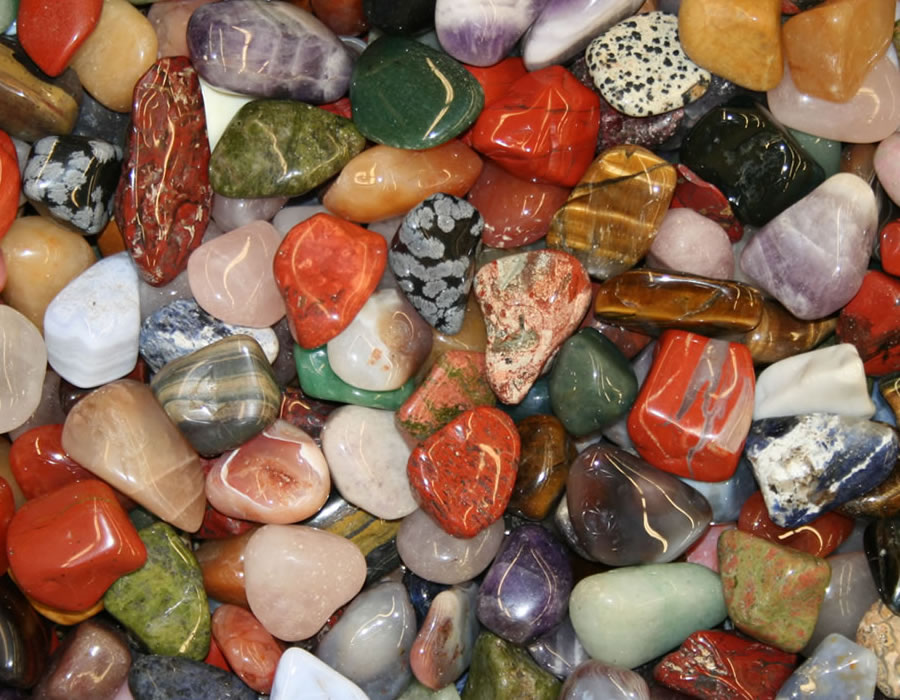
Jasper is an opaque and fine grained variety of Chalcedony. It is found in all colors including: red, brown, pink, yellow, green, grey/white and shades of blue and purple. It often contains organic material and mineral oxides which give it interesting patterns, bands and colors. Many of these patterns resemble landscapes with mountains and valleys, thus the name "picture" is part of the name of many well know jaspers. Jasper was a favorite gem in ancient times and is referenced in Greek, Hebrew, Assyrian and Latin literature. Found worldwide, a wide variety of named jaspers is found in the western areas of the Unites States; California, Oregon, Idaho, Utah, Wyoming and Washington. Picture jasper is a petrified or silicated mud that dripped into gas pockets in molten lava. It became superheated and then solidified forming the unusual banded patterns which are typical of this stone. A 6.5-7 on the Mohs scale of hardness. Back to Top
K2- Afghanite in Granite

K2 – Afghanite in Granite. Composition: Aluminum Silicate Hardness 6. This is a newly found and quite rare stone which takes its name from where it was discovered, in the foothills of the world’s second highest mountain, Mount K2, in the Karakoram Range in Pakistan. This is a stone with a striking visual appeal! K2 Stone is a rare, high vibration and powerful stone, helping us to have more control over our own emotions and to feel much more centered and balanced. It is an excellent stone to promote harmony within a group. It promotes empathy within us and helps us to understand other people’s point of view. It is also good for those who suffer from OCD. K2 Stone is also a powerful stone of peace and goodwill. Back to Top
Kunzite - Collectors love kunzite for its color range, from delicate pastel pink to intense violetish purple. Trace amounts of manganese give this pink to violet variety of spodumene its feminine glow. A relative newcomer to the gemstone stage, kunzite was only confirmed as a unique variety of spodumene in the early part of the twentieth century. Some consider kunzite to be an alternate birthstone for February. The pegmatites that yield kunzite are also a source of lithium.
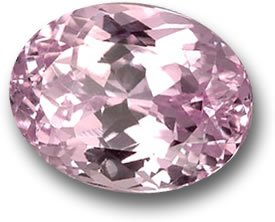
Kyanite
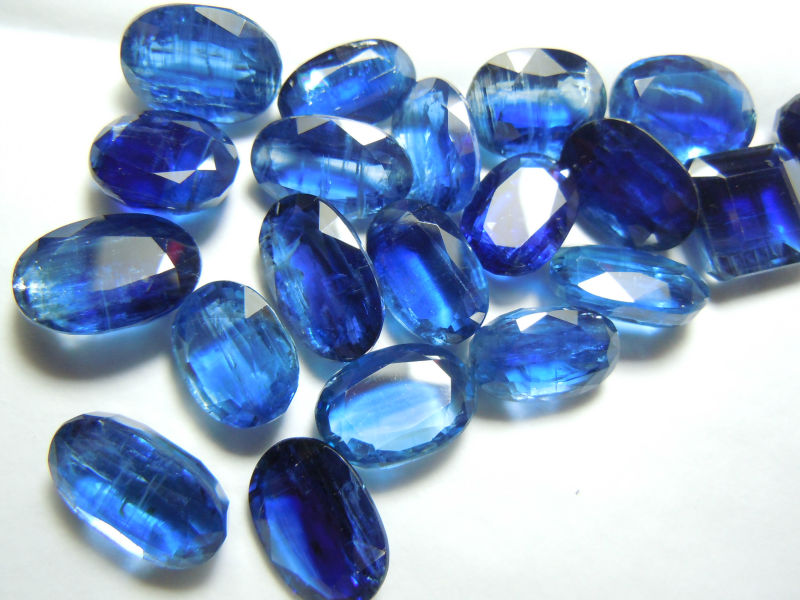
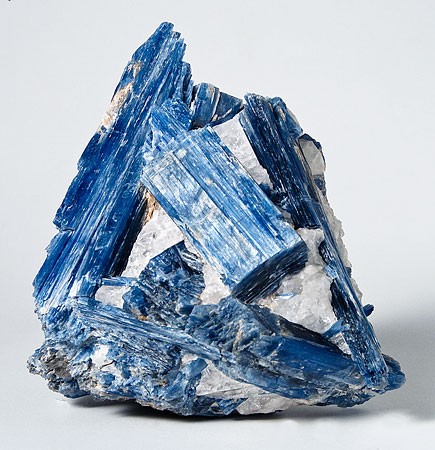
Kyanite is named after the Greek word for "blue". Its color indeed can make it a lovely gem with a near sapphire-like blue. Usually its color is blue but also can be colorless, white, gray, green or yellow. Color is often not consistent throughout the crystal, often showing white streaks in a medium blue. Luster is vitreous to almost pearly. Its variable hardness is a significant characteristic that has to be taken in consideration by the gem-cutter. Hardness is 4- 4.5 (Mohs scale) when scratched parallel to the long axis of the crystal and 6-7 when cut perpendicular to or across the long axis. Kyanite is believed to aid self-expression, communication and supernatural abilities. In ancient times it was believed that a kyanite suspended from a human hair could fallow the Earth's magnetic force like a compass needle. In those times travelers took kyanite along with them, when they entered unknown territories. Back to Top
Labradorite
Laboradite - Named after Labrador, Canada, where it was found in 1770, it is also found in Finland, Madagascar, and Australia. When viewed at certain angles, labradorite exhibits such captivating color it led to Eskimo legends stating that the Northern Lights shone down on the shores of Labrador and were captured inside these colorful stones. The spectral play of color is a result of tiny, desirable inclusions. Labradorite is thought to be a magical stone that possesses powerful protective properties and helps its wearer to find their true path in life and provide its wearer with insight, and to bring peace to its wearer. The most valued type of labradorite, Spectrolite, comes from Finland. It is a 6-6.5 on the Mohs scale. Back to Top
Lapis Lazuli
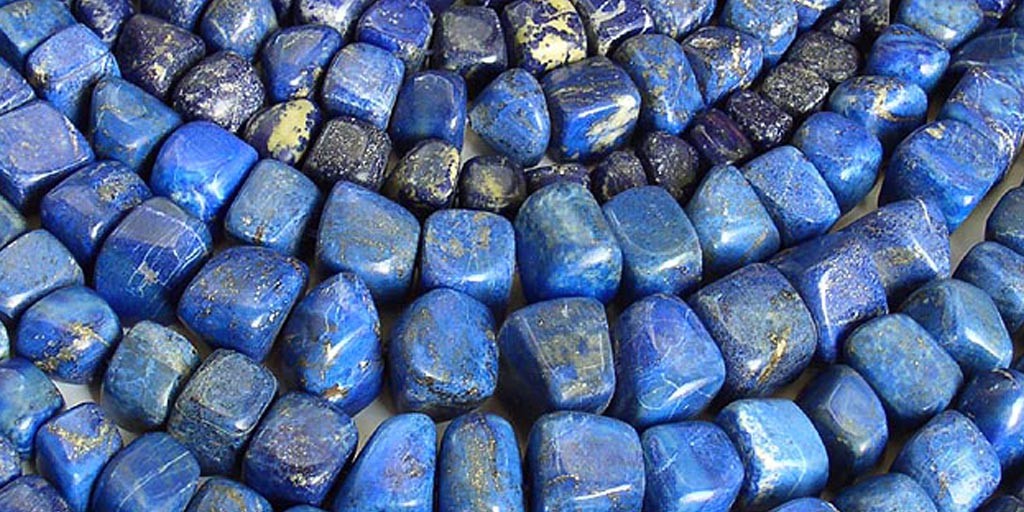
Lapis Lazuli is considered a rock, not a mineral. It combines various minerals, mostly lazurite, but also contains calcite (white), sodalite (blue) and pyrite (fools' gold, a metallic yellow) and to be considered a mineral it would have only one component. Top quality lapis lazuli comes from Afghanistan where is has been mined for more than 6000 years, but is also found in Siberia, Chile, the U.S., Pakistan, and Canada. One of the most famous uses was in the mask of Tutankhamen. The Egyptians used Lapis for seals, ground it for an eyelid cosmetic and often carved it into vases and figurines. A soft stone, 5 -5.5 on the Mohs scale of hardness, lapis lazuli is one of the most valuable semi opaque stones. It has been worn in the belief that it will protect the wearer from evil and is considered one of the power stones in the universe and is said to be good for your psychic awareness. Back to Top
Larimar
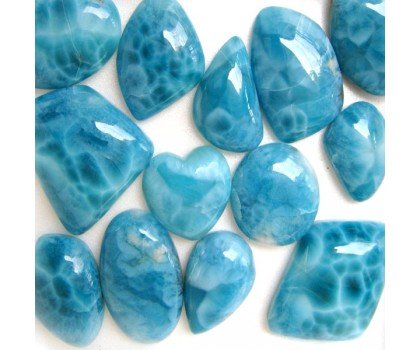
Larimar– was originally discovered in 1916 by a Spanish priest. It has an extraordinary blue appearance similar to the color of the ocean in tropical areas and is found in only one square mile of the earth in the Dominican Republic. The name "Larimar" comes from a combination of Larissa and Mar and was given to the stone by a Dominican who named the stone after his daughter Larissa and Mar, the Spanish word for sea. Its real name is Pectolite, and ranges from 5-7 on the Mohs scale. Once the rock is extracted from the mine it is sent to be graded – usually only about 8% is suitable for jewelry use. Due to the rarity of the stone, better quality Larimar is scarce which is why shapes are often freeform, utilizing as much of the natural stone as possible. Its powers are believed to helps us view events from different perspectives, to soften and enlighten, to heal the emotional, physical, mental and spiritual body. Larimar represents peace and clarity, healing and love. Larimar is reputed to be helpful for those experiencing stress and anxiety. Metaphysically, Larimar is often associated with Atlantis. The vibrational frequency of Larimar is one of the highest of any gemstone leading the stone to be associated with increasing the wearer’s skills of speech and communication. It is also said to have the ability to draw one soul mate to the wearer. Back to Top
Malachite
Malachite is a popular stone which has light and dark green banded areas. Many beautiful specimens of malachite contain special combinations with other minerals, such as azurite, cuprite, or chrysocolla. Malachite has a long history as a gem. The Egyptians used it as early as 4000 BC. In the Middle Ages people in Europe often hung malachite on cradles to assure peaceful sleep for their children and protect them from witchcraft. Malachite can be found in Zaire, USSR, Germany, France, Chile, Australia, Arizona and New Mexico/USA. It ranges between 3.5 to 4 on the Mohs scale of hardness. Its powers are said to include: protection, power, peace, love, and success in business. It is worn to detect impending danger, and is assumed to break into pieces when danger is near. It is the guardian stone of travelers and promotes inner peace and hope and provides protection and security. Malachite clears and activates the chakras and attunes to spiritual guidance. It opens the heart to unconditional love. Back to Top
Moldavite
Moldavite is a member of the tektite family. The most popular theory is that about 20 million years ago a meteorite shower fell in the Moldau Valley of Czechoslovakia and the result of this shower was moldavite, a rare crystal of a bottle-green, translucent hue. Moldavite inspires interest mostly because of its mysterious origins. Colors range from medium dark to yellowish grayish green. Some specimens have gas bubbles and can be found smooth, scarred, or with pitted surfaces. Moldavite has been prized by numerous cultures for more than 25,000 years. Moldavite is legendary for improving career and relationship matters. Wear the ancient secret used for millennia to decrease anxiety, increase confidence, improve relationships, and alleviate health issues. Moldavite can give instant relief for panic and anxiety. It is believed to be one of the 12 power stones of the Universe. Back to Top
Mookaite Jasper
This stone is actually a fossil that formed deep in a Lower Cretaceous marine environment around 120 million years ago! It is a particularly colorful and highly prized gemstone variation of a type of rock called radiolarite that is largely composed of silica from the skeletons of unimaginable numbers of minute marine organisms known as radiolarians. Each radiolarian is only 0.1–0.25 mm long and they are a major part of the ocean's zooplankton. Their skeletons slowly accumulate on the floor of the ocean at a rate of a few millimeters every thousand years. Gradually the muddy ooze is compacted to form a hard flinty rock. The colors and patterns emerge as mineral-rich groundwater soaks through the rock. This stone is mined exclusively in the Kennedy Ranges of Western Australia.
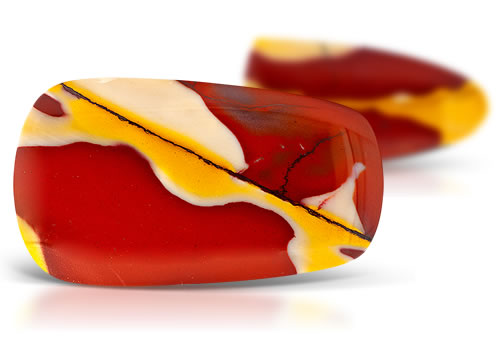
Moonstone
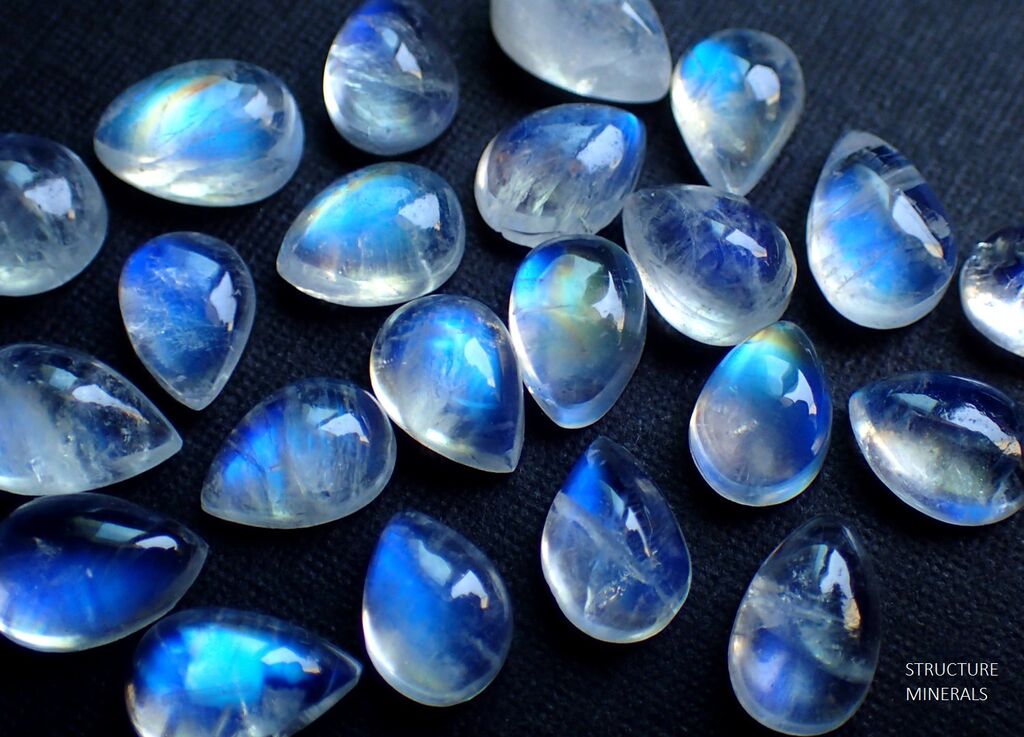
Moonstone – According to Hindu mythology, moonstone is made of solidified moonbeams. It was once believed if you held one in your mouth during a full moon, you could see your future. Its internal structure scatters the light and creates a phenomenon called adularescence. Legends say that moonstones bring good luck. It is the birthstone for June. It is mainly found in India, Myanmar, and Sri Lanka. In India, moonstone is known as a sacred stone and is believed to bring good fortune. It is a highly prized gift for lovers as it arouses tender passion. Back to Top
Mother of Pearl
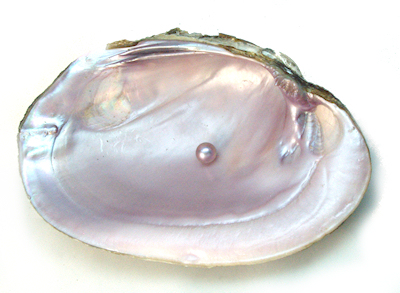
Mother-of-Pearl is similar to pearls in chemical composition, but unlike a pearl, which is the result of nacre secretions emitted to protect the mollusk from a foreign irritant entering the shell, mother-of-pearl comes from the actual shell of the animal. This natural secretion of calcium carbonate and aragonite causes the two main visual aspects that define mother-of-pearl: pearly luster and iridescence. Although far more abundant, and therefore, far less valuable than pearls, mother-of-pearl has been a major component in jewelry and decorative arts for thousands of years. From ancient Egypt and Persia, to ancient China, mother-of-pearl has been a prized semi-precious gemstone throughout human history. As part of the shell building process, the mollusk will deposit layers of calcium carbonate held together by an organic horn-like compound called conchiolin. This combination of calcium carbonate and conchiolin is called nacre or mother-of-pearl. Back to Top
Ocean Jasper
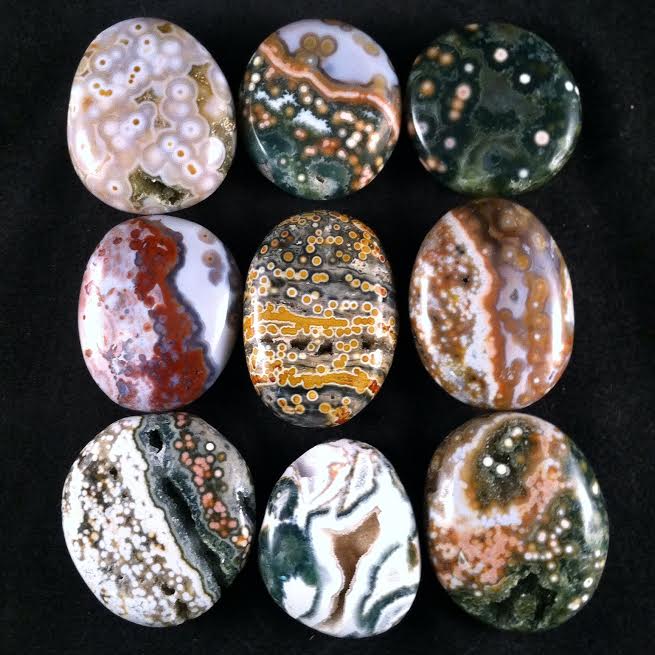
It is said to promote enjoyment of life, release of negativity and stress, relaxation, positive self expression, and physical and emotional healing. Ocean Jasper radiates positive energy and helps one to feel, speak and act more positively. Spiritually, it is said to help release 'stuck' or limiting patterns that may cause physical imbalance or disease. Physically it is said to help with regeneration of tissues in the body, healing of organs, balancing the glandular system, stabilizing the thyroid and assisting the endocrine system. Back to Top
Onyx
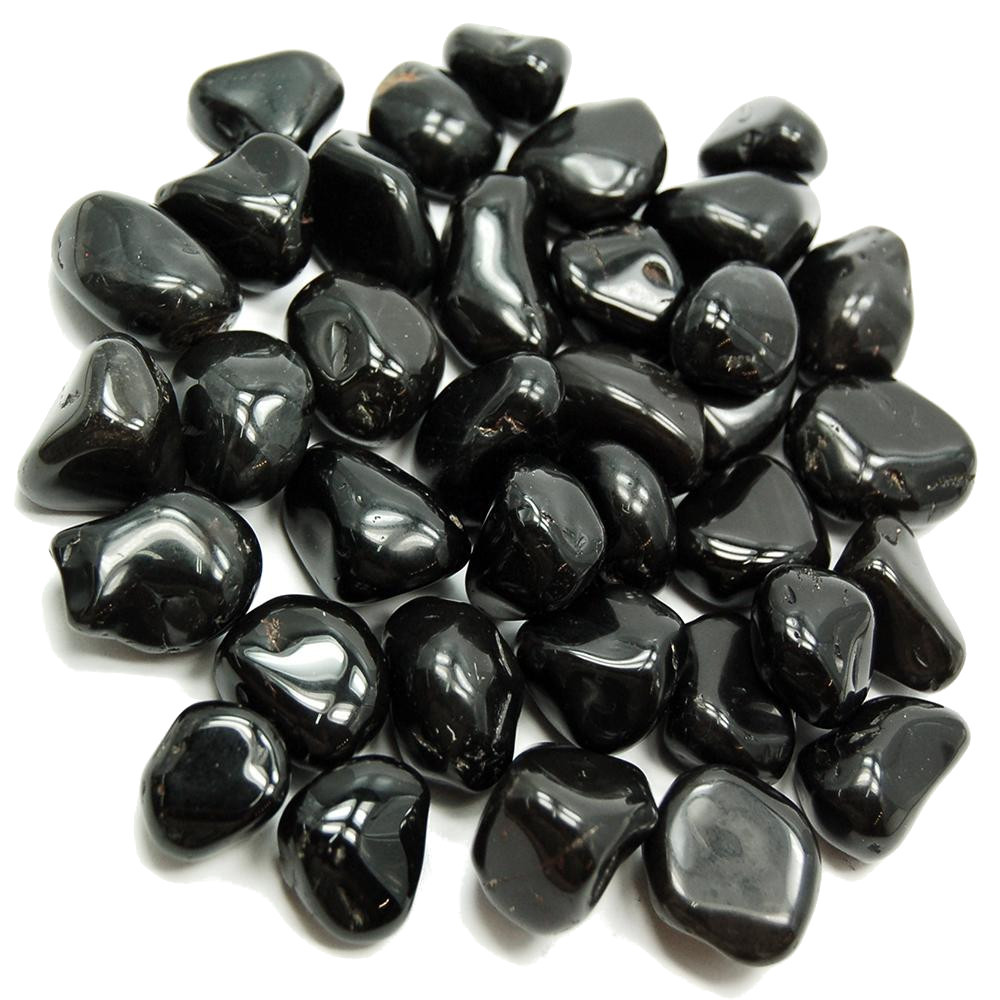
Onyx is a chalcedony quartz that is mined in Brazil, India, California and Uruguay. It has a fine texture and black color; however some onyx also displays white bands or ribbons against a black or brown background and this variety is known as sardonyx. The name comes from the Greek word onyx which means nail of a finger or claw. Legend says that one day while Venus was sleeping Eros/Cupid cut her fingernails and left the clippings scattered on the ground. Because no part of a heavenly body can die, the gods turned them into stone which later became known as onyx. Originally, almost all colors of chalcedony from white to dark brown and black were called onyx. Today when we think of onyx we often preface the word with black to distinguish it from other varieties of onyx that come in white, reddish brown, brown and banded. A 6.5 on the Mohs scale of hardness., onyx is a very good stone for use in carving. Onyx is thought to increase regeneration, happiness, intuition, instincts and also thought to decrease sexual desire and helps to change bad habits. Back to Top
Opal

General opal classifications are: "Boulder Opal" which is opal on a dark ironstone matrix, "Crystal Opal" which is transparent to semi-transparent black, semi-black or white opal which has a play of color; "Fire Opal" or which is translucent to transparent, with yellow, orange, or red body color; "Contra Luz Opal" which is a precious opal where that only displays a play of color when held up to the light ;"Matrix Opal" or "Mass Opal" which has thin seams of precious opal in an ironstone matrix.
Boulder opal is a nodule or concentration that was deposited as a thin layer in the matrix of ironstone, basalt, sandstone, etc. and is more stable than thicker examples of opal. These concentrations can occur as round or elongated ellipsoids, or as horizontal bands. Bolder opal from Queensland, Australia — one of the only known sources for true boulder opals — has gained in popularity and price because of its availability, display of colors and superior stability. Mexico has a special place in the opal world. It produces both precious opal and common opal that is called "fire opal" because of its yellow to orange to red body color. Some specimens of fire opal can be faceted because of their high clarity, but most fire opal is somewhat cloudy. This cloudiness in precious opal, which comes from internal structures such as the balls that defract the light, is called opalescence.
Peruvian opal is relatively rare and is only found in the Andes mountains near San Patricio, Peru. It is a very translucent stone with color similar to the Caribbean Sea. Depending on how the stone is cut it can be clear, scenic (showing varying degrees of color) or dendritic which has black fern like inclusions. Peruvian opal ranges between 5.5 and 6.5 on the Mohs scale of hardness. Back to Top
Orthoceras
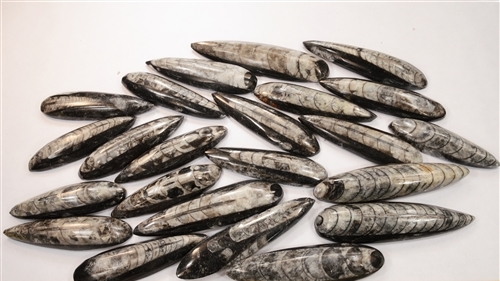
Orthoceras are from the Devonian Period and are more than 400 million years old and are the earliest recognizable animals Orthoceras fossils really inspire the imagination. They were fearsome hunters. Their head grew tentacles and they had a sharp beak in the center of their mouth. The crystallized chambers make a bright contrast to the dark black or brown matrix that surrounds the fossil. Craftsmen polish this matrix to bring out the details of the fossils. They are ancestors to the modern day squid. Even though they were among the earliest forms of life, this class of nautiloid is still considered one of the most intelligent forms of ocean life. The Orthoceras ranged in size from a few inches in length to over six feet! They could swim as well as crawl on the ocean floor. By filling the chambers in their shells with air they could float through the seas propelling themselves by squirting jets of water. As they died their shells accumulated upon the ocean floor, and then were covered by sediments they transformed into stone over the ages. Having a long straight shell their fossils have an iridescent gemlike quality when polished. Back to Top
Peanut Wood
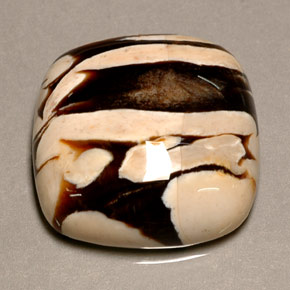
"Peanut wood" is a petrified wood, generally of a black color with numerous borings, which were made by a marine wood-boring bivalve, Teredo. This petrified wood was called peanut wood by the first people who found it, because they obviously thought that the light colored areas resembled peanuts. These light colored areas are what used to be boreholes in the original wood. Before the wood was petrified, it was washed into the ocean as driftwood. It was then attacked by small marine shellfish called "Teredo" ...another name for these little clams is "shipworm". They bore a small tunnel into the wood and eventually the entire piece can be riddled with boreholes. When the wood became waterlogged, it then sank to the bottom of the ocean and settled into the mud. The boreholes then filled with the light colored sediment and then began to petrify. It is found along the edges of the Kennedy Ranges about 100 miles inland from the coastal town of Carnarvon, Western Australia. The age is Cretaceous which makes it around 70 million years old. Back to Top
Pietersite
Pietersite - The fibrous structure in Pietersite (related to Tiger's Eye) has been folded, stressed, even fractured and/or broken apart via the Earth's geological process. The fibrous materials have then been reformed and naturally recemented together by quartz. Stones and crystals that go through this process create a finished product with multiple colors, hues, and superb chatoyancy that can form in swirls, swathes, and fibrous segments and give it a change of color that moves along the surface of the gemstone as it is viewed from different angles. African Pietersite is the most sought after due to its wide range of colors, of which blue is the rarest. Back to Top
Pearl
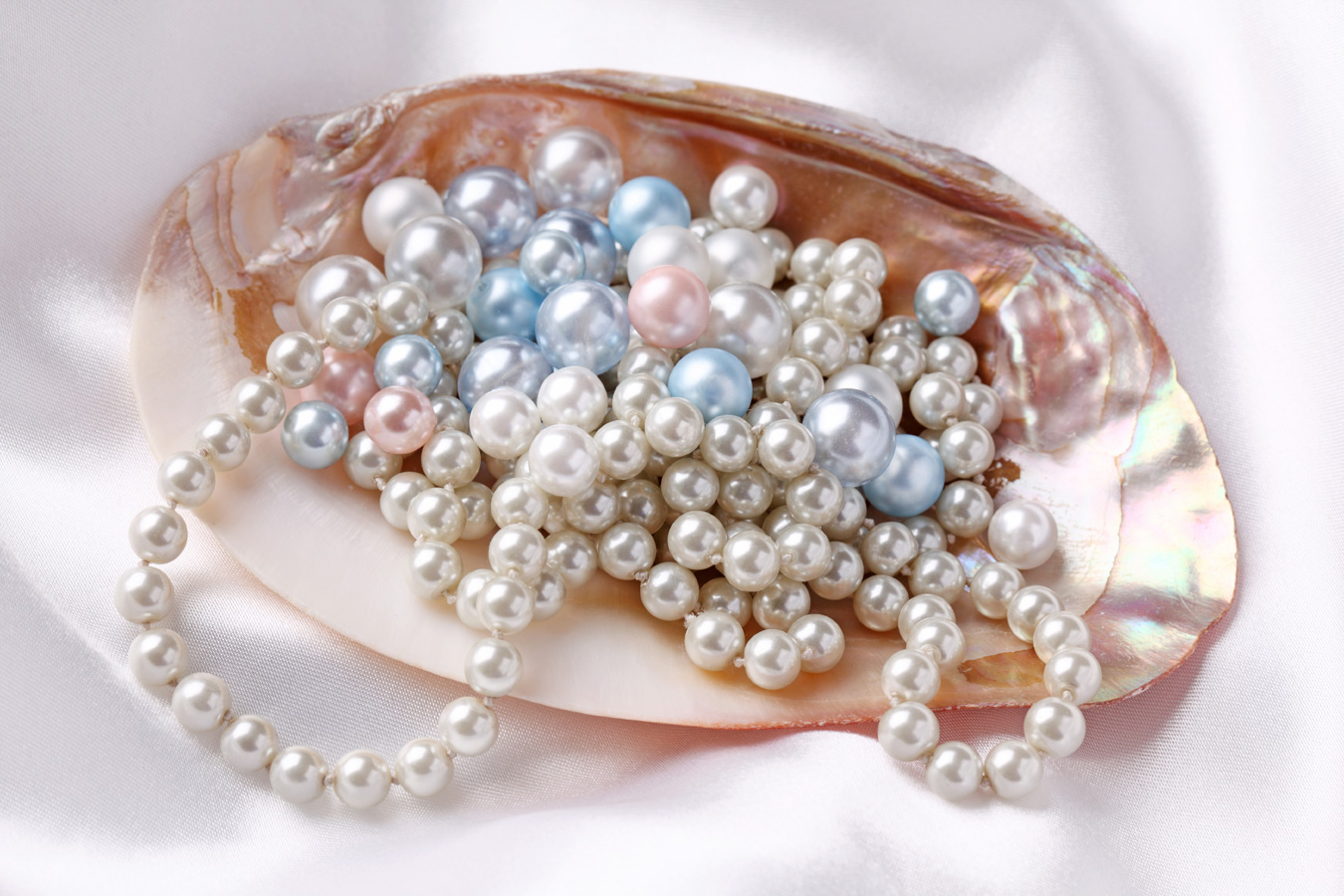
Pearl is the official birthstone for the month of June. An organic gem, pearls are formed inside mollusks such as oysters and mussels. They are formed when an irritant such as a tiny stone or bit of sand gets inside the mollusk's shell. A lustrous substance, called nacre, is secreted around the object to protect the soft internal surface of the mollusk. As layer upon layer of nacre coats the irritant, a pearl is formed. Light that is reflected from these overlapping layers produces a characteristic iridescent luster. This process of building a solid pearl can take up to seven or eight years. The most valuable pearls are perfectly symmetrical, relatively large and naturally produced. They have a shimmering iridescence which is called orient luster. The principal oyster beds lay in the Persian Gulf, along the coasts of India and Sri Lanka, and in the Red Sea. Chinese pearls come mainly from freshwater rivers and ponds, whereas Japanese pearls are found near the coast in salt water.
There are many types of pearls:
natural pearls (made without human interference),
cultured pearls (made when a foreign substance is intentionally inserted into a living oyster. This method was first used in 1893),
baroque pearls (pearls that have irregular shapes),
Biwa pearls (an irregular shaped pearl which forms in the freshwater of Lake Biwa, Japan),
blister pearls (pearls which grow attached to the inside of the shell),
black pearls (gray to black pearls),
freshwater pearls (pearls which form in fresh water mollusks and resemble puffed rice),
Mabe pearls (cultivated blister pearls ),
seed pearls (small, tiny pearls used in Victorian jewelry and sewn on clothing).
Pearls vary in color from white to those with a hint of color, often pink, to brown or black. Each coloration will depend on the type of mollusk and the water where the mollusk lived. Because the nacre is organic, pearls are very sensitive to extreme heat, acids, dryness, and humidity. Care should be taken when storing them. Pearls are quite "soft" and range between 2.5 and 4.5 on the Mohs scale of hardness. They should be protected from extreme wear. Natural pearls have been harvested from the Persian Gulf, the Gulf of Manaar (Indian Ocean), and the Red Sea for thousands of years. The coasts of Polynesia and Australia produce mainly cultured pearls. Both freshwater and saltwater pearls are cultivated in Japan and China. Freshwater pearls occur in the rivers of Scotland, Ireland, France, Austria, Germany, and the USA (Mississippi)
Cultured or freshwater pearls are considered to offer the power of love, money, protection, and luck. Pearls are thought to give wisdom through experience, to quicken the laws of karma and to cement engagements and love relationships. They are thought to keep children safe. Early Chinese myths told of pearls falling from the sky when dragons fought. Ancient legend says that pearls were thought to be the tears of the gods and the Greeks believed that wearing pearls would promote marital bliss and prevent newlywed women from crying. The pearl is considered to be an emblem of modesty, chastity, and purity; and they symbolize love, success and happiness. Back to Top
Peridot
August’s birthstone is a gem quality specimen of the mineral Olivine.and ranges between 6.5 and 7 on the Mohs scale of hardness. Peridot comes from the Arabic word “faridat” which means “gem”. The Crusaders bought Peridot to Europe in the Middle Ages from St. Johns’ Island in the Red Seawhere it had been mined for over 3500 years. Legend says that peridot was one of the favorite gemstones of Cleopatra and that some of the "emeralds" worn by her were actually peridot. It is thought to bring the wearer good luck, peace, and success,. Its powers include health, protection, and sleep. The advantages of peridot are to attract love and calm anger while also soothing nerves and dispelling negative emotions. Back to Top
Prasiolite - Mint Amethyst
Prasiolite is a gem with which one can really be confused. It is traded with variety of names and sometimes mistaken with expensive gems like Green Beryl, Peridot and Tourmaline. The green variety is also named as Vermarine, Lime Citrine or Green Amethyst. Inexpensive, but a true collector's gemstone. The name, prasiolite has been derived from the Greek words "Prason" and "Lithos," which mean 'leek,' due to color similarities with vegetables, and 'stone' simultaneously. It is believed that prasiolite facilitates the gap between the physical and spiritual aspects of life. It attracts prosperity through strengthening the mind, emotions and will. The color of prasiolite varies from pale yellow green to that with the deeper shades of green. This stone is ideal for everyday wear and it is perfect for a wide variety of applications. It is mined in Brazil and Arizona (USA). The hardness of prasiolite is 7 on Mohs scale. Back to Top
Prehnite
Prehnite is a relatively rare Calcium mineral that was named after Dutch Colonel Hendrik von Prehn when it was discovered in 1788. Prehnite is known in China as Putao Yu, or "Grape Jade" due to its nodular crystal habit which can appear like a bunch of pale-green grapes. Prehnite exhibits a distinct pearlescent (mother-of-pearl) effect. Although prehnite is a relatively common mineral, especially in basalts, the gem variety of prehnite is considered rare. With a hardness of 6 to 6.5, prehnite is not a soft gem. It is also a tough stone that is suitable for high quality jewellery. One unique characteristic of prehnite is its ability to "glow" in sunlight. The radial fibrous structure of the gem is also an advantage in that, if cut correctly, it can exhibit a cat¹s eye, or "moonstone"effect. Back to Top
Psilomelane
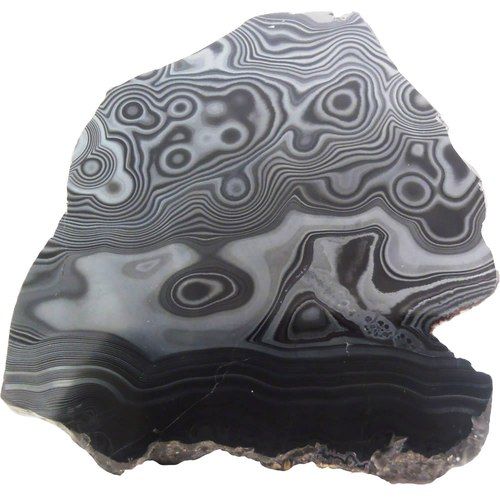 The name psilomelane (from the Greek words for “smooth” and “black”) refers to its typical black, smooth-surfaced, grape-bunch-shaped. Psilomelane is often banded with gray pyrolusite and the alternating layers make an attractive polished stone with bands of metallic gray and submetallic black. Psilomelane is a stone that is considered excellent for gazing and scrying. It is used in mysticism for out of body travel and gazing at any distance. It is an essential ingredient in steel and other alloys.
The name psilomelane (from the Greek words for “smooth” and “black”) refers to its typical black, smooth-surfaced, grape-bunch-shaped. Psilomelane is often banded with gray pyrolusite and the alternating layers make an attractive polished stone with bands of metallic gray and submetallic black. Psilomelane is a stone that is considered excellent for gazing and scrying. It is used in mysticism for out of body travel and gazing at any distance. It is an essential ingredient in steel and other alloys.
Quartz
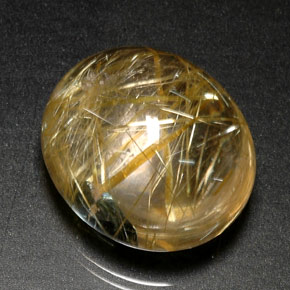
Quartz is the most common mineral on Earth. It is found in nearly every geological environment and is a component of almost every rock type. It makes up about 12% of the earth's crust, occurring in a wide variety of igneous, metamorphic and sedimentary rocks. It is also the most varied in terms of variety and color. Quartz is a 7 on the Mohs scale of hardness. Rutilated quartz is found in Australia, Brazil, Kazakhstan, Madagascar, Norway, Pakistan and the United States. Rutile is a major ore of titanium, which is a metal used for high tech alloys. It often forms needle-like crystal inclusions inside quartz. This form of quartz is known as rutilated quartz and it looks like small bars of imbedded gold. Rutile is a 6 on the Mohs scale. Because of the difference in hardness between the two materials and because of the way rutile forms inside, this can be a difficult stone to attain a smooth surface without pits. Rutilated quartz has been referred to as Cupid's darts, Venus hair stone and Fleches d'amour. The name quartz comes from the Saxon word querklufterz which meant cross vein ore. The name rutile comes from the Latin word rutilus meaning red. It is said to brings forth each person's strengths, originality, aids sleep, relate to others. Rutile is said to intensify the metaphysical properties of its host crystal and to enhance one's understanding of difficult situations. It is also said to enhance creativity and to relieve depression and loneliness. Rutilated quartz is said to slow down the aging process and is said to be a strong healer. Back to Top
Ancient Coins
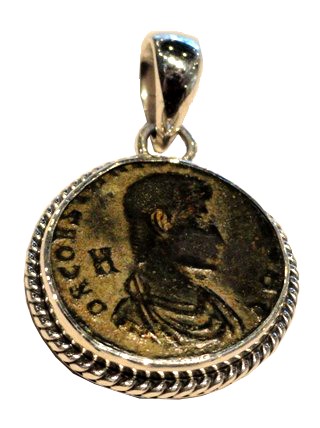
Ancient coins jewelry - These authentic coins set in jewelry hold historical value as well as collectible value. On most of the Roman coins you will see fine detailed portraits depicting the emperors of that time. Sometimes you will also see other important figures such as their wives, generals, or dignitaries. Most of the reverses have symbols such as Victoria (victory), Concordia (harmony), or Fortuna (fortune) just to name a few. On Greek coins you will often see Greek gods and Goddesses depicted, such as Athena - the goddess of peace and war, Apollo - the god of poetry and music, Hercules - son of Zeus and a symbol of strength, and Zeus - the greatest of the Greek Gods, father of all.
Unlike modern coins that have millions of identical strikes, you will rarely see two identical ancient coins. This is because each coin was struck by hand with different alignments, different pressures, and sometimes different temperatures at each strike. Text, or legends on the coin hold the key to being able to identify Roman coins. It is helpful to know some of the abbreviations: IMP meant emperor, CAES for Ceasar, PM for Pontifex Maximus, PF for Pius Felix, AUG for Augustus (the most distinctive title for the emperor). The major categories of Roman coins were:
Greek - circa 625 - 30 BC, Roman Republic - circa 289 -41 BC, Impereratorial - circa 60 -27 BC, Roman Imperial circa 27BC to 476 AD, Roman Provincial circa 27 BC to 297 AD, and Byzantine circa 491 to 1493 AD. Back to Top
Rhodochrosite
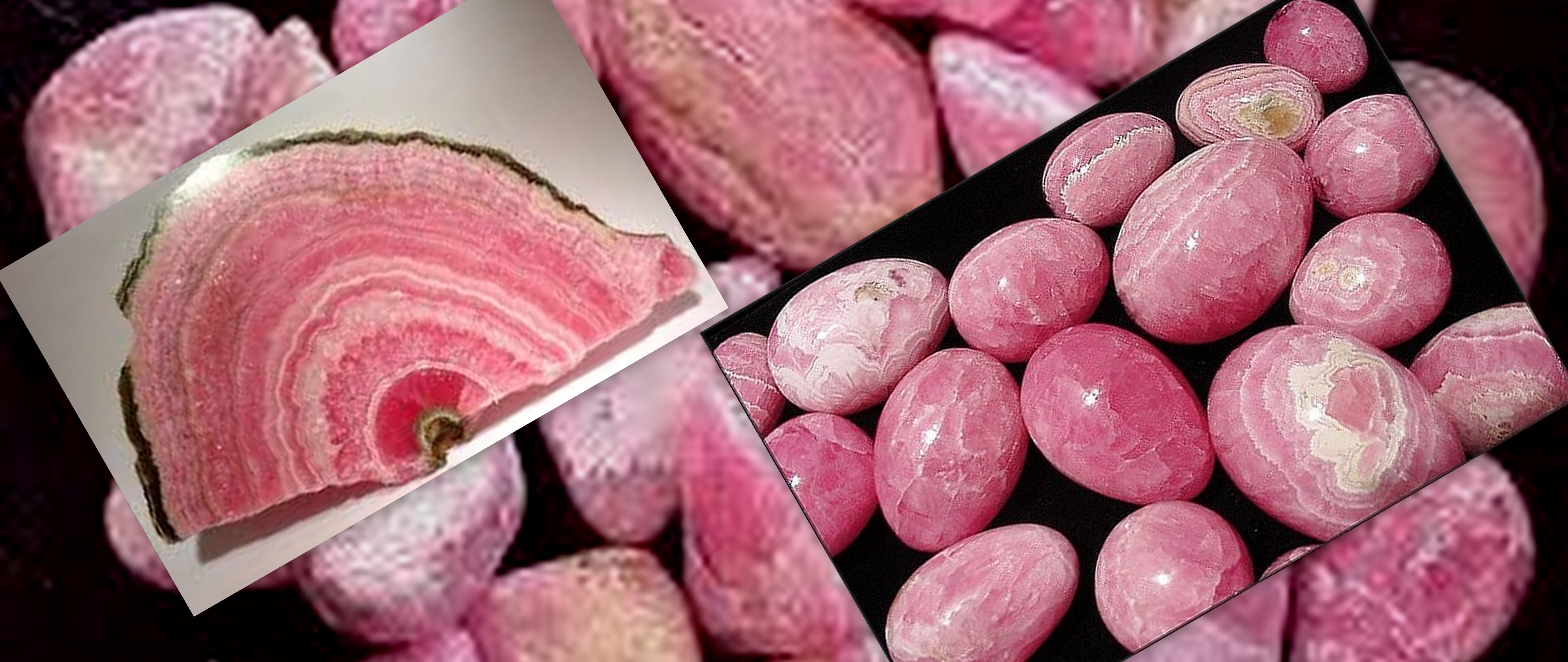
Rhodochrosite, mined in Argentina, occurs as a hydrothermal vein mineral along with other manganese materials in low temperature silver ore deposits, and until quality mineral specimens became highly sought after by collectors, they were often discarded in the mine dump! The Incas believed that Rhodochrosite is the blood of their former rulers turned to stone. So it is sometimes called "Rosa del Inca" or Inca Rose.
Rhodonite, another pinkish stone, is often confused with rhodochrosite because the base color is similar, but most rhodonite used for jewelry purposes contains black manganese oxides while rhodochrosite is banded with white. Rhodochrosite is a relatively soft stone and ranges between 3.5 and 4.0 on the Mohs scale of hardness. Back to Top
Rose Quartz
Rose Quartz is the stone of love and for the Heart Chakra. While the pink color may exude a gentle and soothing energy, it is an incredibly powerful stone. It encourages the release of stored tension and stress, the banishment of anger and resentment, the release of fear and suspicion, and rebirth of hope and faith in the benevolence of the Universe. Placing Rose Quartz in a room will promote an atmosphere with loving and compassionate energies. For those seeking to develop love on all levels, Rose Quartz is a supreme ally.
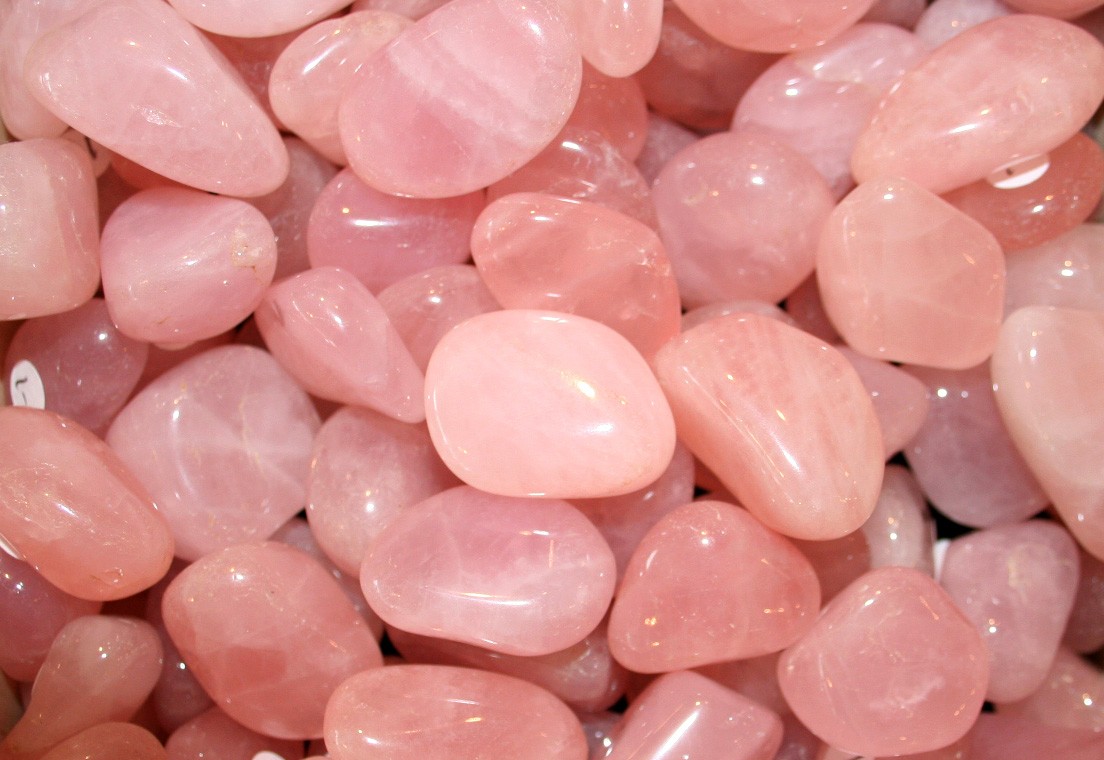
Ruby
In ancient Sanskrit the ruby was known as “ratnaraj” the stone of Kings. Not only the birthstone for July, it is the world’s best loved red gem. The name "ruby"is Latin for 'red.' The fiery red color of ruby was thought to be caused by an inextinguishable flame, lit from within the stone. Rubies belong to the same mineral family (corundum) as sapphire, and are both the hardest, and toughest gems in the world after diamond. They are formed by intense heat and pressure, deep within limestone rich in clay. Rubies can be deep vivid red to pink, purplish to orange-red. Myanmar and Thailand are the best sources for rubies. Medieval Europeans wore it to grant health, wealth, wisdom and success in love.
Ruby Zoiscite
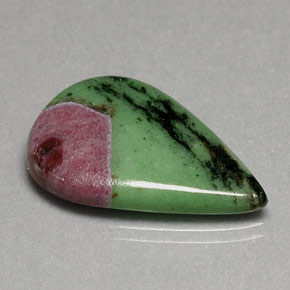
Ruby Zoiscite is an ornamental material consisting of crystalline aggregates of green zoisite with non transparent ruby inclusions it is found in Tanzania and the general appearance is unmistakable. There isn't another stone like it in the mineral world. The green zoisite is relatively soft, between 5.5 - 6.5 while the ruby inclusions are usually quite hard, 9 on the Mohs scale. This can make the stone difficult to cut because of the differences in hardness and usually diamond tools will be used. Zoisite has been known for nearly two centuries as an ornamental stone. The medium grade red ruby material is usually spread irregularly throughout the green zoisite. It is one of the most colorful of ornamental stones.though green and blue are quite rare. Back to Top
Sapphire
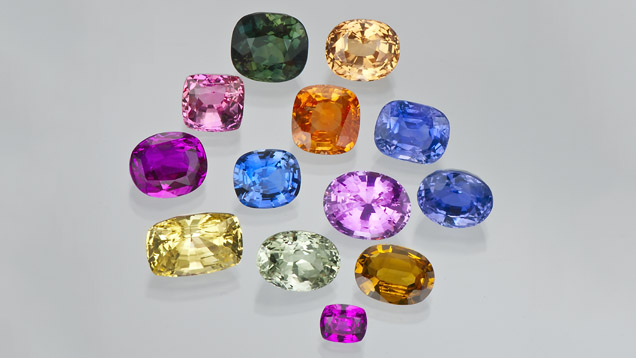
The name "sapphire" was originally derived from Greek "sappheiros," as well as the Sanskrit Kuruvinda "sanipruja" meaning "hard stone," and the Hebrew word "sappir" meaning "gem." The biblical "Acts of the Apostles" referred to Sapphira, a woman who was executed for lying to the Holy Ghost. Back to Top
Silver
Silver has always been surrounded by mystery. Known since prehistoric time, Man learned to separate silver from lead as early as 3000 B.C. The Incas called it "the tears of the moon" because they were awed by silver's gleam. As early as 700 B.C. Mesopotamian merchants used silver as a form of exchange. The ancient Greeks minted the drachma, which contained1/8th ounce of silver. And let's not forget the English shilling "sterling", originally denoting a specific weight of silver, and now has come to mean excellence. Sterling silver is 92.5% silver and 7.5% copper.
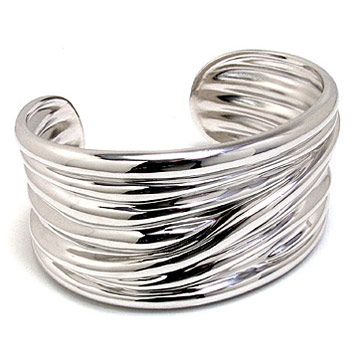
Smoky Quartz
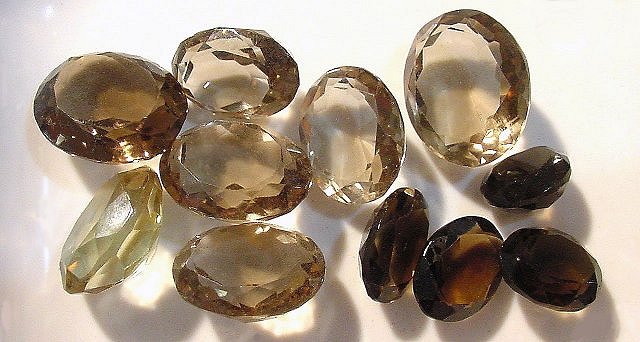
Smoky Quartz - First of all, while it is commonly called topaz, this brown gemstone is actually quartz. Before its chemical make-up was known, people believed this sultry stone was a member of the topaz family and, as a result, the name still lingers even though we now know differently. Though the names are interchangeable and refer to the same gemstone, the correct name is smoky quartz. The reason the name smoky topaz is still used is because it is the name people are familiar with and it makes it easier to find what they are looking for. The jeweler can then explain the difference. Topaz is made of fluorine aluminum silicate whereas smoky topaz quartz, like all the members of the quartz family, is a silicon dioxide. It is possible that aluminum particles contaminating the mineral are what give the stone its smoky brown color. Another possibility is that radiation from the earth pulls the color out. Sometimes clear quartz is enhanced through irradiation to achieve shades of brown. A smoky topaz can come in shades ranging from pale tan to a dark chocolate. Like amethyst and citrine, smoky topaz quartz is a macrocystalline quartz. This means that the crystals forming the gemstone can be seen without magnification. Another interesting characteristic is that it is sometimes found in combination with citrine creating a bi-colored stone.
Smoky topaz quartz was found long ago in the mountains of Scotland. In fact, it is the official gem of Scotland. As a tribute to this brown gemstone, smoky quartz serves as the tip of the national scepter. Since the beginning of time, people and cultures have attached mystical characteristics to gemstones. Smoky topaz quartz is no different. For one thing, it is believed that wearing the gemstone draws out negativity from the wearer as the gemstone absorbs it. This is why it is also believed to relieve depression and improve mood. Dreams may become reality when wearing a smokey quartz bracelet or other piece. As for health, the workings of the bodys lower organs- digestive and reproductive- are supposed to be improved. A common use for a smoky topaz is as a meditation facilitator. It supposedly raises awareness, clears the mind and enhances reaction time. Overall, it is supposed to help the wearer tune in and come to resolution. Another mystical use for smooth round spheres of smoky topaz quartz is as a scrying stone. It is believed that, in the 16th century, Elizabeth I relied on them to tell the future. Taking advantage of its mystical ability to see the future, smooth crystal balls are also made from this mysterious gemstone. Back to Top
Sodalite
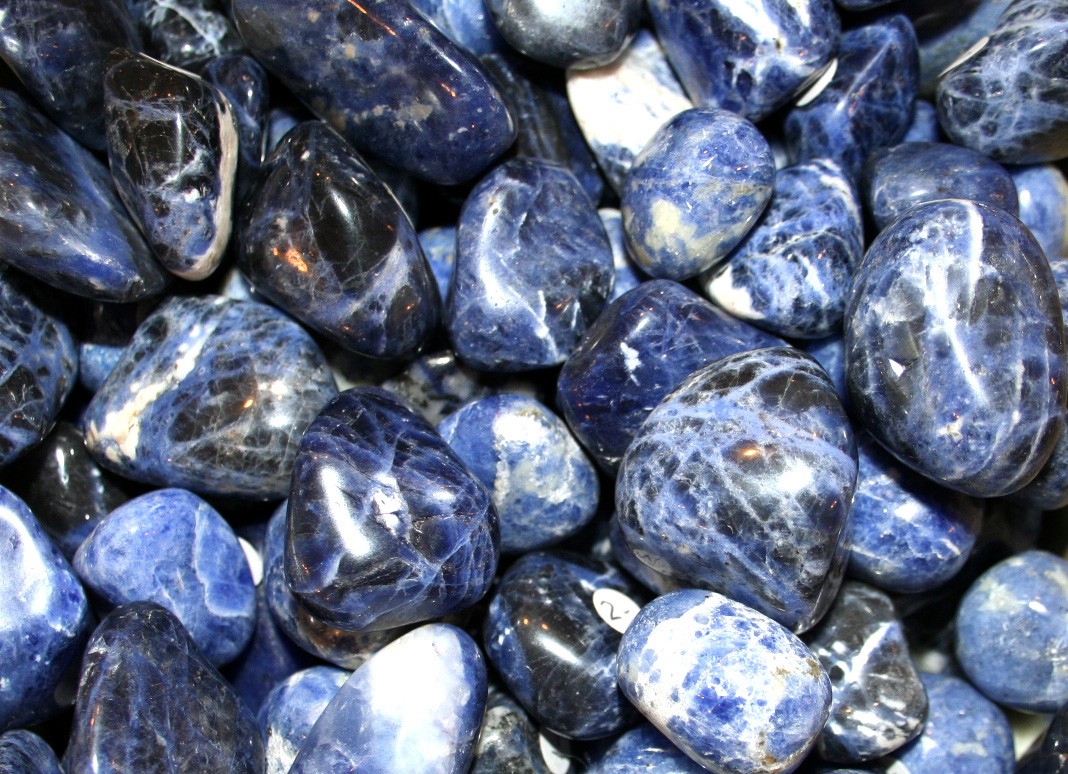
The name comes from the Greek words soda and lithos, which means salt stone, as the stone contains a lot of salt. is used for carvings and some jewelry pieces where its light to dark pure blue color is well known in the semi-precious stone trade Sodalite meaning is based on its use as a stone of the head and heart. Because Sodalite is focusedon the head it is considered a gemstone of logic and truth. It can help with learning and enhances intelligence by clearing confusion that can arise when your intuition is going against conventional wisdom. Sodalite is also a stone of the heart and is considered a calming stone. It can help to end arguments because it makes clear communication possible. Sodalite is especially useful for creative people, the combination of heart and mind makes it possible to make your visions a reality. The calming effect can help create order in the chaos that often surrounds creative types. Back to Top
Staurolite
Also known as the Fairy Cross Stone, Staurolite was believed to be formed from tears the fairies shed when they heard the news of Christ's death. It is traditionally known as a protective stone and a talisman for good luck. Staurolite enhances and strengthens rituals and is said to be used in white magic ceremonies. The Fairy Cross connects the physical and spiritual planes, promoting communication between them. Staurolite also can be used to assist in the relief of depression, addictions and stress and is said it is also a stone for those who wish to stop smoking by grounding energy to those who use nicotine to anchor themselves to the earth.
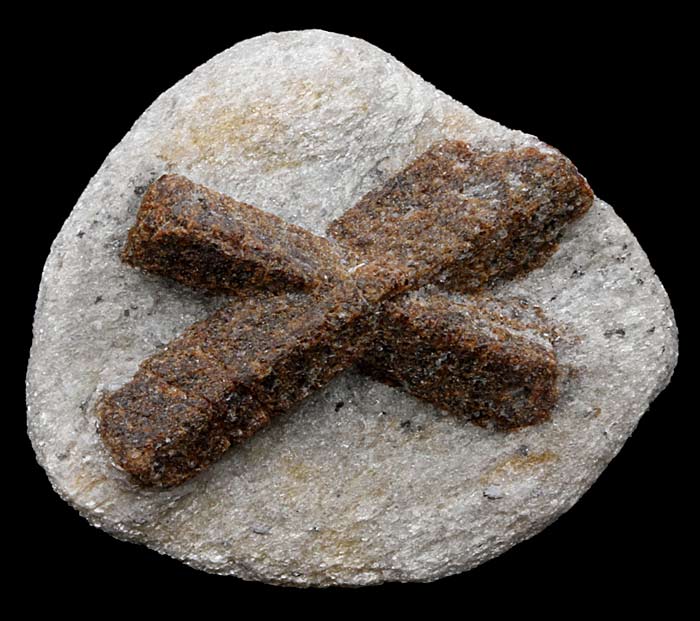
Sugilite
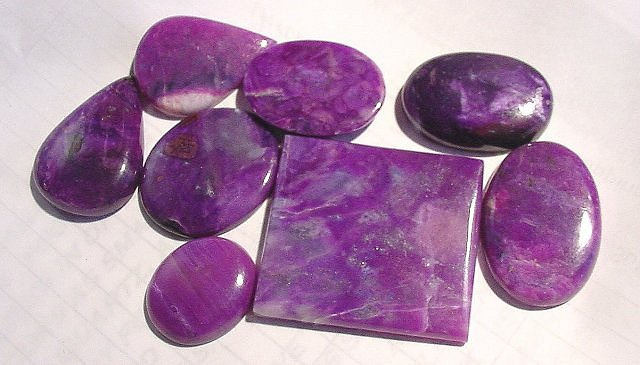
Sugilite, a fairly recent discovery (1944) is found in Japan, Canada and India. The most important occurrence was found in 1975 in the Kalahari Desert, Northern South Africa. Sugilite is named for the Japanese geologist who discovered the first specimens, Ken-ichi Sugi. It is opaque with a waxy luster and ranges from a pale grayish lavender to a deep dark purple. Sugilite is also known under the trade names of "Royal Lavulite" and "Royal Azel" Sugilite often contains black matrix, reddish brown or yellowish blotches and ranges between 6 - 7.5 on the Mohs scale of hardness. Bright purple stones with little matrixing or blotches are the most valued. Gem grade sugilite is beautifully translucent and because it is quite rare it brings a high price. Back to Top
Tanzanite
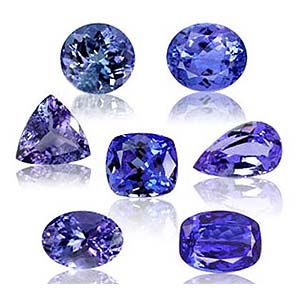
|
Found in just one place on earth this blue variety of zoisite was named for Tanzania, the country where it was found, by Tiffany & Co. Crystals show different colors depending on viewing direction. In the short time since discovered in 1967, it has become the second most popular blue gem after sapphire. It is one of the most valuable of all metaphysical crystals for spiritual exploration, bringing together all aspects of communication and psychic power. |
Tiger's Eye
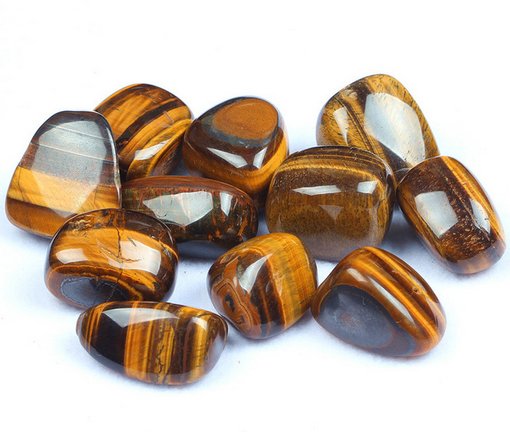
Tiger’s Eye – (tigers eye, tiger eye, tiger iron) is a member of the quartz group of chalcedonies. It is one of the chatoyant gemstones. Chatoyancy exhibits a changeable silky luster as light is reflected within the thin parallel fibrous bands. This effect is due to the fibrous structure of the material. Tiger iron is composed of tiger's eye, red jasper and black hematite. The rippled wavy bands of color often resemble a scenic view. Tiger's eye is mined in Western Australia, South Africa, USA, Canada, India, Namibia, and Burma. Many legends about quartz say that wearing tiger's eye (which is a form of quartz) is beneficial for health and spiritual well being. Legend also says it is a psychic protector, great for business, and an aid to achieving clarity. Back to Top
Topaz
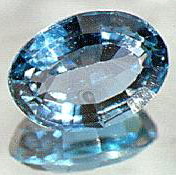
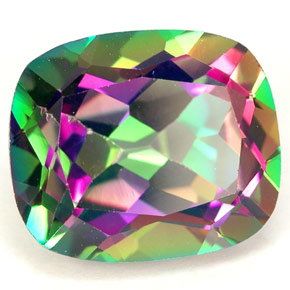
Topaz – occurs in a wide variety of colors and is found all over the world. The name topaz comes from the Sanskrit word “tapaz”, meaning fire. In the 15th century, topaz was used to detect poisons, calm anger, and break spells. Christians believed topaz stood for uprightness, and to Hindus, topaz worn above the heart prevented thirst and assured long life, beauty, and intelligence. The Greeks felt topaz gave them strength and used it as an amulet against harm. The Egyptians believed that topaz was colored with the golden glow of the mighty Sun God Ra. This made topaz a very powerful amulet that protected the faithful against harm. The Romans associated topaz with Jupiter, their God of the Sun. During the Renaissance people believed it could break magic spells. In ancient times it was believed that topaz helps to improve eyesight. The Greeks trusted topaz's supernatural power to increase strength and make its wearer invisible in times of emergency. Topaz was also said to change color in the presence of poisoned food or drink. Its mystical curative powers changed with the phases of the moon. It was said to cure insomnia, asthma, and hemorrhages.
A new high tech enhancement process applied to colorless stones such as topaz and quartz has created a new variety we call "Mystic Topaz." Mystic Topaz displays a stunning rainbow effect that makes it all at once unique, fashionable and different. The color, brilliance and clarity of the final product depend on the quality, cut and polish of the original gemstone. That's why we use only first quality topaz for our mystic topaz. Mystic topaz displays all the colors of the rainbow in one stone. The shades of color are displayed in kaleidoscopic designs. Transparent, eye clean topaz of the finest quality is our only choice for the raw stone is used for Mystic Topaz. Colorless topaz, our raw basic material, is always untreated. In order to convert eye clean colorless topaz of fine quality into Mystic topaz, a high tech process known as thin film deposition is used. The cut and polished topaz is coated with an extremely thin titanic film. Very little heat is involved in the process that produces the optical effects. The treatment is durable, hard, and only a few microns in thickness. With care, the enhancement will last the life of the jewelry setting. Back to Top
Tourmaline
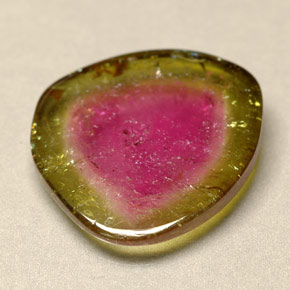
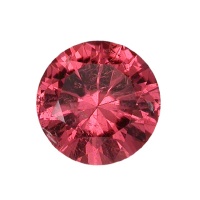
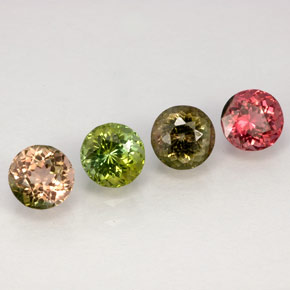
Tourmalines - Tourmaline derives from the Singhalese term "turamali", which translates as "stone of mixed colors." October’s birthstone comes in a wide variety of colors. Rubelite is pink to red, Indicolite is violet to blue, Paraiba is intense blue, chrome tourmalines are green, achroic are clear, and also the beautiful watermelon tourmalines of green and pink. They can be white and black as well. It can show every tone from pastel to dark, and can appear in various colors in the same stone. The many different colors of tourmaline mean that this stone can easily be mistaken for just about any other gemstone. Many stones in the Russian Crown Jewels from the 17th century once thought to be rubies are actually tourmalines. The major source for tourmalines is Brazil.
They are believed to protect the wearer against bad decisions, many dangers, and misfortunes. It is also known to attract friends and lovers. Pink tourmaline promotes female balance and protection, as green tourmaline promotes the same among men. Tourmalines are believed to protect the wearer against bad decisions, many dangers, and misfortunes. It is also known to attract friends and lovers. Back to Top .
Turquoise
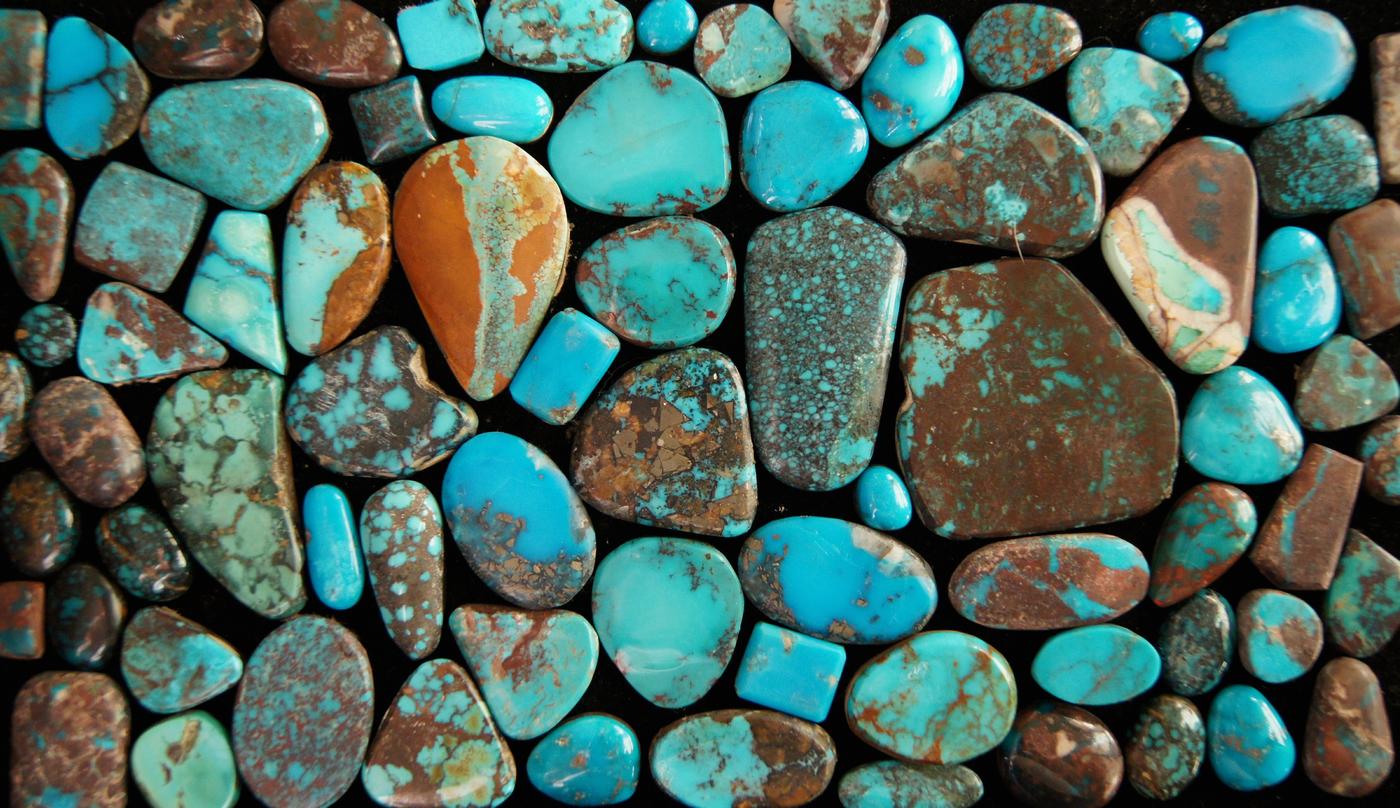
Turquoise – Persian turquoise was introduced to Europe via Turkey where it gets its name from – Turk’s Stone. Egyptian royalty wore turquoise as long as 5300 years ago. Turquoise is a purification stone. It dispels negative energy and can be worn to protect against outside influences. Turquoise balances and aligns all the chakras, stabilizing mood swings and instilling inner calm. It is excellent for depression and exhaustion, It is a symbol of friendship, and stimulates romantic love. It has been associated with horses for centuries by protecting any rider who wears the stone from injury if they were to fall off. In the 17th century, turquoise was only considered effective is received as a gift. Native Americans in the Southwest saw the stone to be sacred, and Tibetans today consider the stone for good fortune, health, and as a protector against the evil eye. Back to Top
Uvarovite
Uvarovite is one of the rarest of the garnet group minerals and is the only consistently green garnet species, with an emerald-green color. It was first discovered in 1832. One major source is in the Ural Mountains of Russia that yields Uvarovite druzy - tiny crystals that are deposited on a matrix surface. This is a calm and peaceful stone, helpful in experiencing solitude without loneliness. Spiritually it helps us recognize the universal and endless nature of the soul.
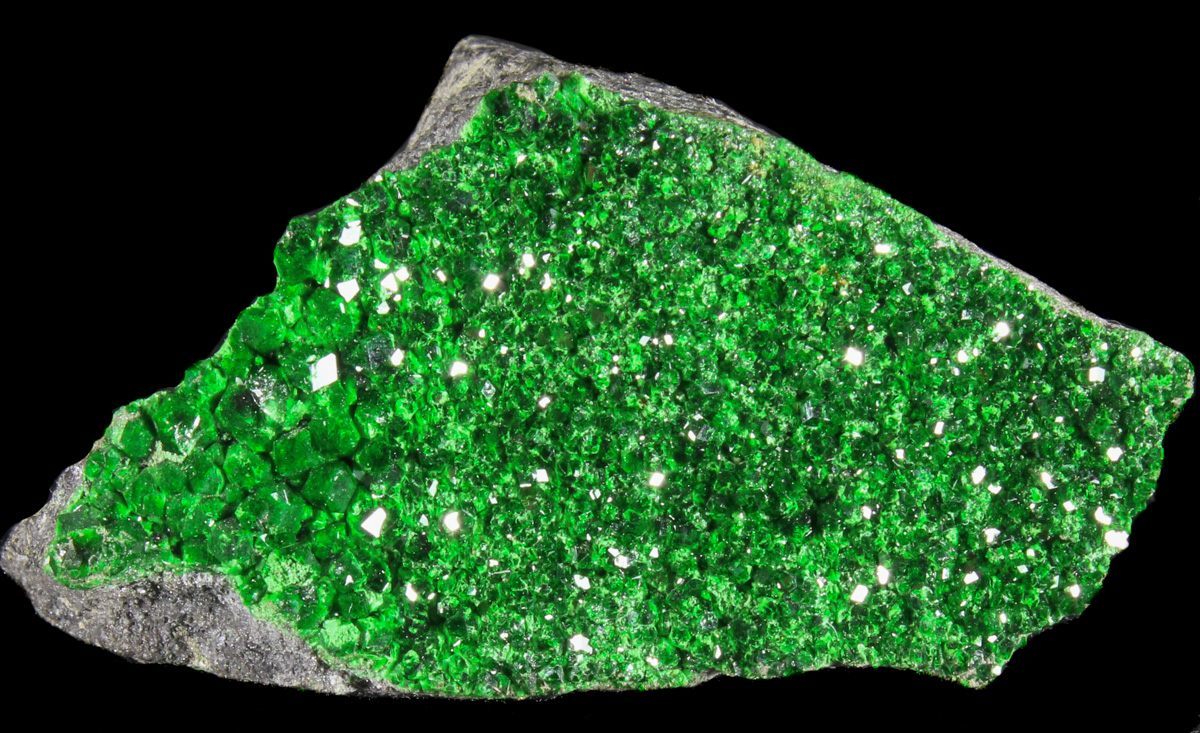
Variscite
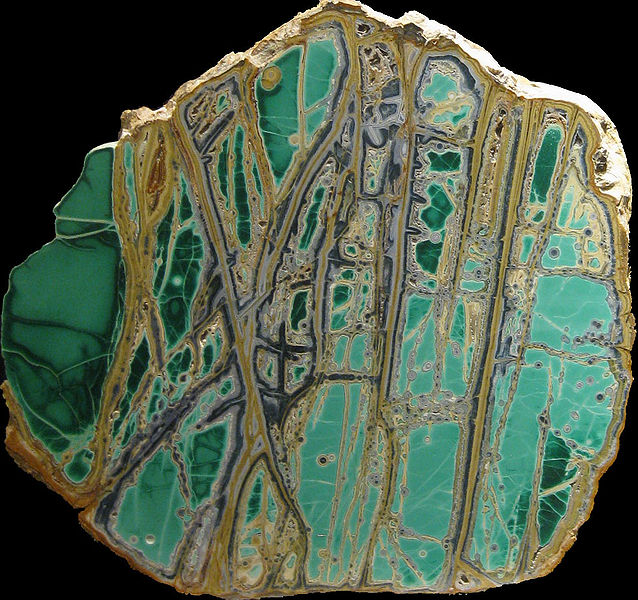
Variscite is a relatively rare phosphate mineral that is sometimes confused with chrysocolla or the greener forms of turquoise. Colors are light bluish green, medium and dark greens. It has a waxy luster and takes a fine polish. Variscite is found in the United States (Utah, Nevada), Australia (Queensland), Germany and Brazil. A search on the web shows a wide range in hardness for this stone spanning 3.5 to 5 on the Mohs scale of hardness. It is said to help with remembrance of past lives, balance the central nervous system and ease depression, fear, worry, anxiety and impatience and is a good meditation stone. It is also believed to help with virtue, self-reliance, moral courage and success. Back to Top
What makes a Precious Metal
Like gemstones, one of the characteristics of a precious metal is its rarity. It could not be "precious" if it were common! Two other characteristics are also important. Foremost is durability - it must not easily corrode away, nor can it be brittle. And that is related to the third characteristic, ductility. This means that the metal must be malleable, that it can be bent, hammered, or otherwise shaped. Gold is the most malleable of metals (it can be hammered into incredibly thin foils or drawn into extremely fine wires), it does not corrode or dissolve except under the most extreme conditions. It is so durable that nearly all of the gold ever mined is still in circulation or storage.
Silver
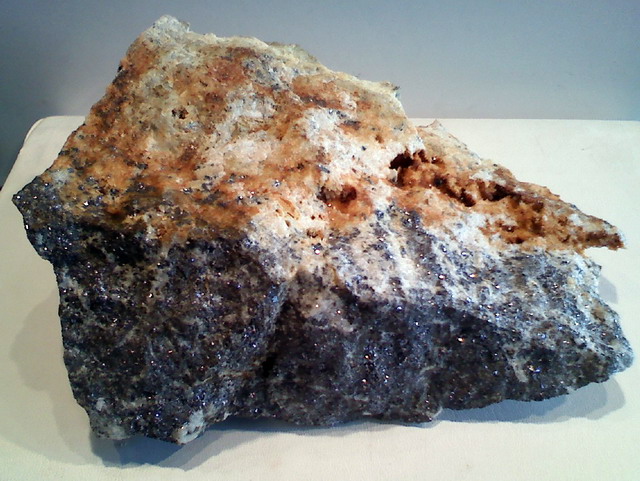
Most silver is a product of lead mining. The main silver mining areas of the world are South America, the USA, Australia, and the former USSR. The greatest single producer of silver is probably Mexico, where silver has been mined for almost 500 years. As early as 700 B.C. Mesopotamian merchants used silver as a form of exchange. The ancient Greeks minted the drachma, which contained 1/8th ounce of silver. And let's not forget the English shilling "sterling", originally denoting a specific weight of silver, and now has come to mean excellence. Silver has always been surrounded by mystery. The Incas of Peru called it "the tears of the moon" because they were awed by silver's strangle gleam, and the Chinese believed that a silver locket hung around a child's neck would ward off evil spirits. Back to Top
Birth Stones
Certain gems have traditionally been associated with different months of the year.
They are: January - Garnet, February - amethyst, March - aquamarine, April - diamond, May - emerald, June - pearl, July - ruby, August - peridot, September - sapphire, October - opal, November - topaz, December - turquoise. Back to Top

